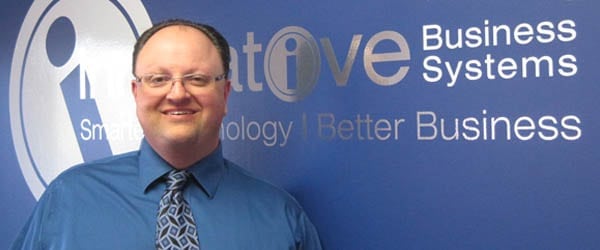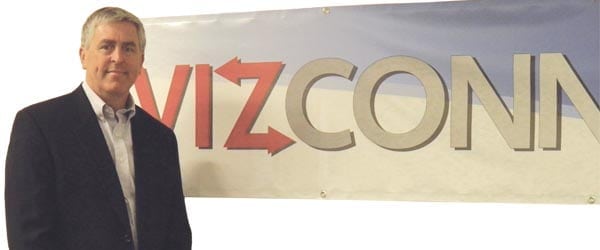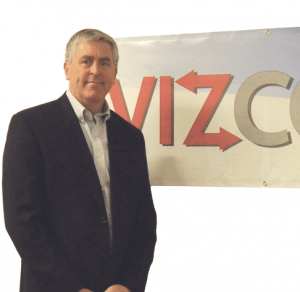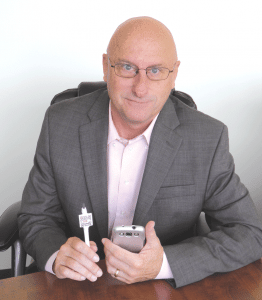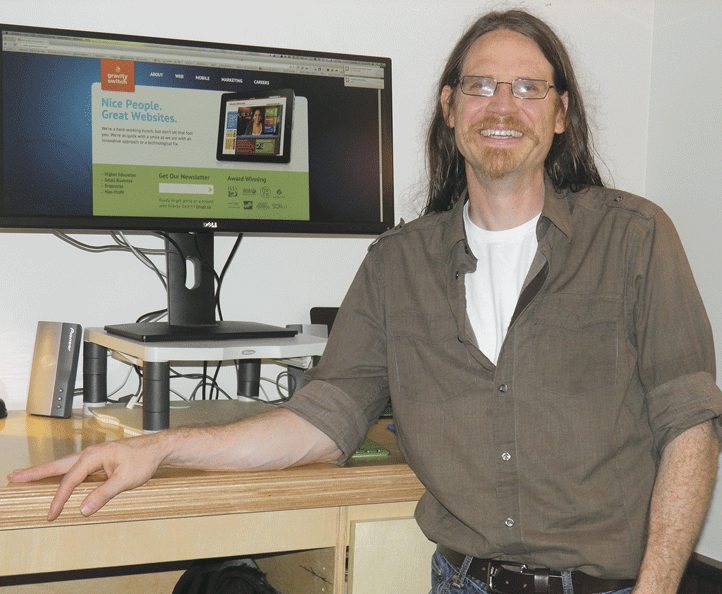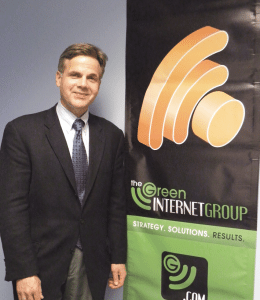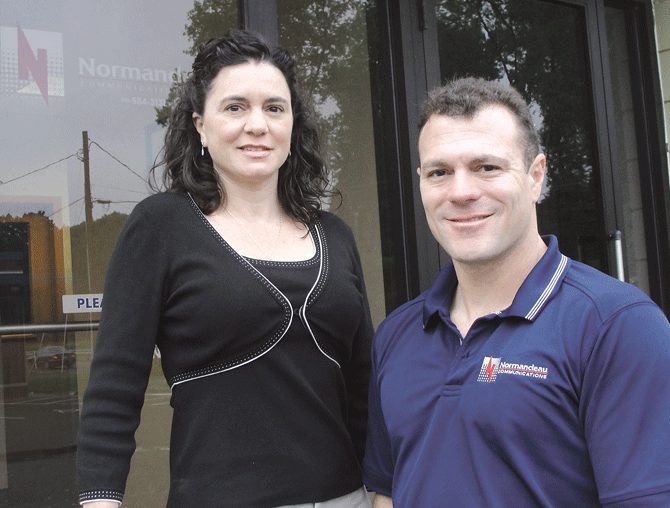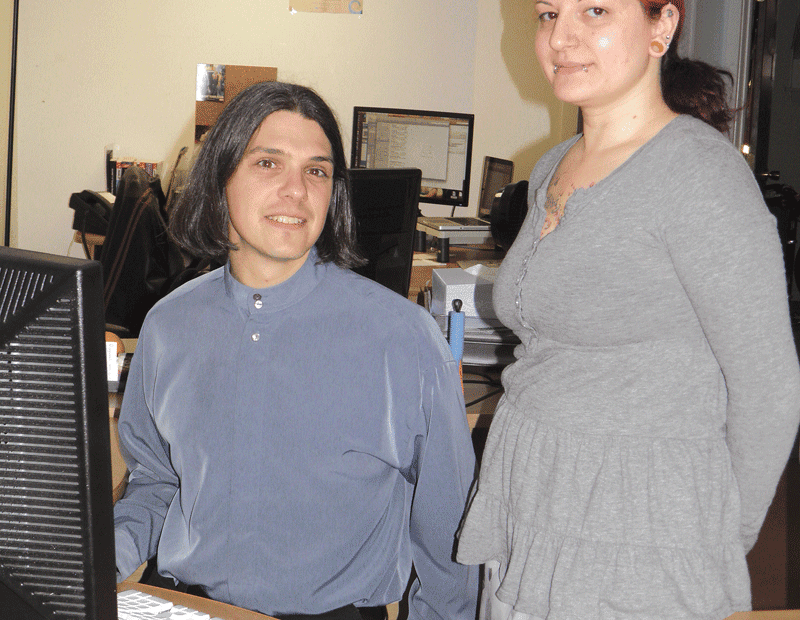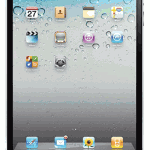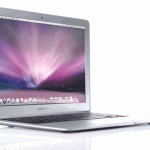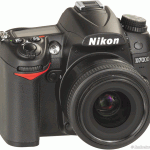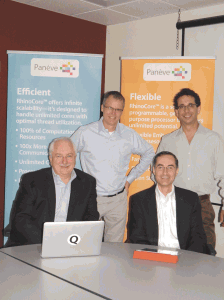Technology
As Speech-recognition Technology Improves, More Applications Emerge
 Speech-recognition technology, which instantly translates human speech into a digital document or command, has been around in some form for about two decades. But constant improvements in performance — as well as a broading of its applications — have users excited about the future.
Speech-recognition technology, which instantly translates human speech into a digital document or command, has been around in some form for about two decades. But constant improvements in performance — as well as a broading of its applications — have users excited about the future.
That performance is typically measured in accuracy and speed, but various factors have complicated the former, from the vocabulary size of the software to the rate of speech; from accented or disjointed speech to background noise.
Dragon NaturallySpeaking, produced by software developer Nuance, has long been considered the gold standard in minimizing such issues.
“At first, speech-recognition packages were more like frustrating toys with maddening limitations, but they have steadily improved over time,” writes Lamont Wood in Computer World, in a discussion about NaturallySpeaking 12, the newest Dragon product. He said the utility of speech recognition didn’t outweigh its limitations until about a decade ago, but even then, speech recognition was more reliable with long words than with short ones, misinterpreted words were often rendered as commands, and the software occasionally got confused to the point that it stopped listening.
With version 12, he notes, “these factors have faded into the background (although they they haven’t entirely disappeared). For example, you can dictate effectively at about half the speed of an auctioneer — should you prove able to do so. Assuming that you stay focused while dictating, the error rate is now trivial.”
That’s important for people who use speech recognition in a variety of fields, including:
• Healthcare. The technology speeds up the transcription process by allowing a medical professional to dictate into a speech-recognition engine and cleaned up by an editor on the back end.
• Military. Speech recognition has been tested successfully in fighter aircraft, with applications including setting radio frequencies, commanding an autopilot system, setting steer-point coordinates and weapons-release parameters, and controlling flight display.
• Air-traffic control. Many air-traffic-control training systems require a person to act as a pilot and dialogue with the trainee. Speech recognition could potentially eliminate the need for that pseudo-pilot, thus reducing training and support personnel.
• Aerospace. NASA’s Mars Polar Lander used speech recognition in some applications.
Other uses are common as well, including court reporting; assistive devices for automobiles, such as OnStar and Ford Sync; hands-free computing; robotics; video captioning for television; and interactive video games — just to name a few.
Taming the Dragon?
Dragon isn’t the only player in the field, however. “Simpler or less expensive (if not quite as powerful) options are carving out little fiefdoms,” writes Mark O’Neill in PC World. “The more choices, the better, too, given that using voice commands can stave off or reduce repetitive strain injuries. The spoken word also suits some projects better than typing.”
Among the lesser-known options are:
• Windows Speech Recognition, which arrives preinstalled with newer versions of Windows. “Performance could stand some improvement,” O’Neill notes. “I found the accuracy level dipped when I dictated long texts into a MS Office doc. Nor did it respond well to my German accent, so other accents may stymie it as well.”
• Google Voice Search, which works on a Google Chrome browser, which is “fairly good at recognizing what you said.”
• TalkTyper, an online app with far fewer features than Dragon. “Even when I spoke clearly, it tripped up on some of the words, and I wasn’t exactly dictating rocket science. TalkTyper should be used only for simpler stuff, shorter spoken content — maybe an email or a tweet here and there.”
• Tazti, an app that goes beyond simple transcription. “Rather than taking dictation, Tazti takes orders. It helps you control games, open apps, and even use the command line,” O’Neill notes. “However, Tazti’s one big drawback is it won’t let you dictate text to a document. It’s not that kind of voice recognition.”
Using voice recognition for commands is increasingly common in automobiles. Although these systems are largely user-friendly, drivers still have to rely on set commands when summoning a phone number or searching through music. But Nuance says systems that recognize true natural language with 95% accuracy are probably no more than three years away.
“I believe the biggest gains to be made are going to be in conversational speech and understanding the intent of what the user is trying to accomplish,” Brian Radloff, the company’s director of Automotive Solution Architecture, told Satellite Radio Playground. “We’re starting to see that in telephony in the mobile space.”
He said strides will come when car makers treat their infotainment systems more holistically, with screen graphics properly tying into speech control. “The bulk of the focus over the next five years in the automotive space, and in voice in general, is going to be, how do we take this experience that is very good for a certain group, and make it very good for a large swath of the car-buying public?”
Meanwhile, Wells Fargo recently began testing voice-recognition technology that banking customers can use to check their spending habits and account level. In addition, U.S. Bank has been testing the technology among its employees, and some insurance companies, including Geico and USAA, have incorporated voice recognition in their applications, according to the Charlotte Observer.
Shirley Inscoe, a senior analyst with Aite Group, a national research and advisory firm, said such advances are closely tied to the rise in mobile devices and consumers demanding to do more with them. “There’s a big desire to improve customer service. They know we as consumers don’t go anywhere without our mobile phones. It really is a way to tie a customer more closely to the financial institution.”
Other advances in voice recognition go well beyond finance and leisure activities. For instance, two MIT students recently spent their winter break in New Jersey developing a device that could give paralyzed people the ability to call for help with the sound of their voice or change the settings on their wheelchair when no one is around. They were inspired by retired physics professor Michael Ogg, who has multiple sclerosis.
“My real limitation now is because of MS. I’m completely quadriplegic. I’m just not able to move my arms and legs at all,” Ogg told the Asbury Park Press.
He relies on home health aides for daily assistance, but when he is alone, he cannot reach an alarm by his bed to summon aid. “In the case of … being able to call for help,” he said, “this is potentially life-saving technology.”
Speak Clearly
Whichever voice-recognition software one uses, Wood offers a few tips to make the technology easier and more effective, including enunciating carefully and speaking slowly enough so that each word gets its due; watching the results on the screen as you go along, which can enhance accuracy; and taking heed of background sounds.
“Background silence is best, but droning ventilators hurt recognition more than office chatter,” he writes. “Meanwhile, if you don’t mind being overheard on the phone, then you won’t mind being overheard while dictating. You can use about the same volume for the phone and for speech recognition.”
Put that way, the ever-improving realm of speech recognition can be thought of as just another office function, as it’s increasingly assimilated into many corners of the world, from gaming to aviation to healthcare — a life enhancer for some, but for others, potentially a life-saving development.
— Joseph Bednar
New York Sound and Motion Invests in the Big Picture
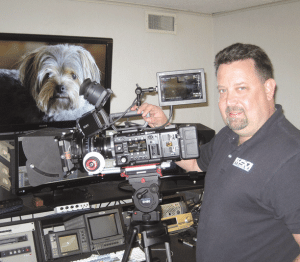
Ed Brown recently invested in the Sony F55 digital camera, and has targeted Hollywood film productions in Massachusetts as future clients.
When Ed Brown interned for a neighbor’s lighting and gaffing business during one of his college summers home on Long Island, it proved to be a turning point in his life.
He spent the summer of 1989 on the set of the movie Quick Change, starring Bill Murray, Geena Davis, and Randy Quaid. “I worked as a production assistant, and I caught the bug,” recalled Brown, who is now owner of New York Sound and Motion (NYSM), a West Springfield-based, high-end video, TV, and radio production studio.
With almost 25 years of experience under his belt in lighting, filming, and editing, Brown handles production for local clients such as Marcotte Ford, the Eastfield Mall, Rocky’s Ace Hardware, Gary Rome Auto Group, and UTC Aerospace (maker of spacesuits for NASA), as well as educational and healthcare systems, political campaigns, and specialty productions for events like the Naismith Memorial Basketball Hall of Fame’s enshrinement ceremony. He recently invested thousands of dollars in a state-of-the-art digital camera and the necessary support equipment in what he calls a “calculated move” that will bring him full circle, back to the movie-production process that started it all.
Indeed, NYSM is poised, and equipped, to position Brown as a cinematographer, in addition to offering elite production services to some of the largest companies in the world. As his NYSM promotional demo on YouTube states to prospective clients, “you can make it here in Western Massachusetts!”
“I’m going after all the big guns here, and I want them to realize that there is a lot of talent with the right equipment in their backyard; they don’t need to run to Boston or New York for ultra-high-end production,” said Brown, adding that his work is also his hobby, which means he’s always reading and researching the newest products, even on his limited days off.
“I’m able to talk the talk and walk the walk with the big boys,” he told BusinessWest, “but I’m just in a little pond.”
Coming from perhaps the biggest pond — New York City — Brown, like many entrepreneurs, started his production company in the basement of his home in 2002. After spending more than a decade on the road as a videographer shooting and editing for ESPN programs such as NFL Countdown, College Gameday, and Outside the Lines, which had him working mostly weekends, he said he was missing his children’s early years.
By 2006, he’d moved to an office with a large studio in Springfield, and his client base grew, just as technology in both cameras and editing software was advancing.
After a short-lived move to West Springfield, Brown is moving NYSM back to Springfield this spring to take advantage of more energy-efficient space as he embarks on a new chapter in his company’s history.
For this issue’s focus on technology, BusinessWest visited NYSM to gain some insight and perspective concerning the many breakthroughs in lighting, cameras, and editing software that will enable Brown get back to movies and attract the kind of corporate clients he covets.
Light Year
Superior lighting is one of the most important aspects of Brown’s business, and he admits that the biggest challenge in his industry is just keeping up with technology, which has advanced in just the last two years at the speed of, well, light.
He gets most of his education about the newest video-production technology at the National Assoc. of Broadcasters (NAB) convention, the world’s largest electronic media show covering filmed entertainment, video, and sound production, held each spring in Las Vegas.
“It’s the go-to place for technology; I keep up with what constitutes the latest and greatest, and this year, my main reason for attending is to convert all my studio lighting to LED lighting,” he said, noting that LED (light-emitting diode) systems require less power (from 20 amps to 2.5 amps) and produce near-zero heat, which helps with air-conditioning usage and, ultimately, his shop’s electricity expenses. “It’s the right move, and I want to see what’s out there.”
However, Brown explained to BusinessWest that LED lighting technology is still in its infancy; some inexact color-temperature differences, he explained, can seriously affect the cool or warm tinted outcome of a commercial shoot, both indoors and outdoors.
“Color temperature has to be so exact for television shoots, and I don’t care what fandangle camera you have; if the color temperature is off, you’re going to see it,” Brown explained.

Correct lighting, indoors as well as outdoors, is vital for a quality commercial production, as seen at one of Ed Brown’s recent commercial shoots on the streets of New York City.
Brown’s meticulous attention to detail, talent, and accrued equipment add up to production costs that can run 20 times more that they would be for a small local TV-commercial producer, but the result is what he calls “New York-quality commercials.”
A recent shoot for a Connecticut-based bank ran $10,000 for a two-day shoot that involved more than $250,000 worth of equipment on set, and that’s before he hit his editing suite to cut the commercial, at $225 per hour.
However, he said those rates are far less expensive than what high-end production would cost in a large city, and he’s raising the bar even further with his recent purchases.
“I’ve been trying get that Madison Avenue thinking here in Western Mass.,” Brown noted in reference to a strategic initiative that he believes will put NYSM on par with any large-city production house.
Resolution Revolution
Brown’s new production-equipment package, which includes a single digital camera, a powerful new computer, upgraded editing software, and other accessories, cost him just under $80,000.
The main item is the Sony F55 digital camera, which boasts the ability to shoot in ultra-high definition, or what’s known as 4K, which is what ultra-high-definition televisions (UHDTV) require for excellent picture quality. The 4K resolution, he explained, is a generic term for display devices or content having horizontal resolution (DPI, or dots per square inch, which are distinct pixels in the smallest addressable visual element) on the order of 4,000 pixels. While many movies are still shot with 35mm cameras, more and more cinematographers are switching to digital cameras, like the Sony F55 and Red Epic (a competing brand).
But most television stations where Brown’s commercials air are currently high-definition (HD) only, as many home televisions are still only HDTVs.
So, does a 4K camera make sense? His answer is a quick and emphatic ‘yes,’ stressing that it’s all about quality compression — and the future of his industry.
Television broadcasts operate only in HD, or 1080×1920 pixels, but commercials shot in 4K, or four times larger, are compressed and reduced, and the picture quality is still extremely precise, meaning every pore and every hair of the person in the commercial is extremely obvious — “which produces a really big problem,” he said. “I now really need a great makeup artist.” But with makeup professionals experienced in film production working for him, Brown has that base covered.
However, he explained, commercials shot in HD lose their DPI quality every time they are saved in an edited format before being sent to TV stations. One hour of filming in 4K can result in 500 gigabytes of raw footage, which he then edits through a process called color grading. This process maintains the UHDTV integrity until the spot is completed and image size is finally reduced on a file (600 MB or less when sent to TV stations) for airplay.
“It’s why national commercial spots, which are the same quality as what I do, look so much more rich than what is typically regionally produced,” Brown explained.
Editing software has also advanced considerably. Three software programs are currently being used: Apple’s Final Cut Pro; Avid (with which 80% to 90% of all motion pictures are edited); and Adobe Premier Pro Creative Cloud, which Brown prefers. Deciding to spend more time developing smartphones, Apple recently suspended production of Final Cut, but the software and hardware giant isn’t out of the film-editing business, as it’s producing quality computers with power that is “screaming,” he said — “a ton of horsepower in a tiny little box.”
Brown’s newest purchase, the MacBook Pro with Retina Display, is more than a “glorified iPad,” he noted. With almost no produced heat and 16 GB of RAM, an Intel i7 quad core (four central processing units), and terabyte solid-state storage, the slim machine has plenty of power, allowing Brown to process huge amounts of 4K raw video data in conjunction with the Pegasus R6 Raid System connected via Thunderbolt.
All these powerful pieces have Brown excited, but, at times, just a bit overwhelmed.
“It’s such new technology that is so new and so different … that I’m actually a little afraid of it,” he said, adding quickly that, since the holidays, he’s been working with it all daily, and his comfort level is about 100%.
Lights, Camera, Action!
Brown’s next purchase is what he calls the $9,500 trashcan, because it literally looks like a small black trashcan. The new 2013 Mac Pro, a sleek, cylindrical computer as tall as a typical coffee thermos and just a bit wider, offers 12 cores of processing ability (the typical MacBook Pro has only two cores), and even more RAM and processing power, assuring that no future project will be too massive.
He believes these investments will allow NYSM to secure more Fortune 500 clients and take on the brighter lights of Hollywood.
To that end, Brown has been rubbing shoulders with members of the Berkshire Film and Media Commission, which is closely tied to the Mass. Film Office. More than a dozen films were shot in Massachusetts last year, creating revenue of more than $359 million, and Brown, as a cinematographer, wants a piece of that action.
As his investments in expensive technology keep him ahead of the curve, he’ll also target one of the most interesting new prospective businesses in Western Mass. — MGM Springfield, which could become a constant source of high-tech 4K video productions.
“4K technology will be here sooner than you think,” Brown said as he pointed to his large UHDTV screen. “As fast as HD has taken over the market, that’s how fast 4K is going to take over the market … and I’m going after the big fish.” n
Elizabeth Taras can be reached at [email protected]
The Latest High-tech Devices Keep Users Connected
It wasn’t too long ago that Americans used their cell phones essentially to, well, make phone calls, and maybe send text messages and take the odd photo or two.
How times have changed. We live in an era of constant communication, where the phone is now a device for staying connected to social media, making financial transactions, playing games, and engaging in 100 other activities guaranteed to keep people staring downward.
They’re called smartphones, and they have evolved over the past five years from a useful tool to a ubiquitous part of the way people interact. According to the Pew Research Center, 56% of all Americans own one (91% own a cell phone of some kind), and that percentage is constantly on the rise.
And that’s why BusinessWest begins its annual feature showcasing the newest and best-reviewed high-tech tools with a few of the leading choices in smartphones.
 For starters, Apple’s iPhone continues to lead the pack. Business Insider calls the latest iteration, the iPhone 5S ($199+), the top choice among 2013 models. “Yes, it looks nearly identical to last year’s iPhone 5. Yes, there are plenty of other smartphones out there that are just as good and can do a lot more things. Yes, the screen is relatively tiny compared to a bunch of the giant Android phones out there. But that doesn’t matter,” the magazine notes, because the phone boasts an ideal balance of power, useful features, and design.
For starters, Apple’s iPhone continues to lead the pack. Business Insider calls the latest iteration, the iPhone 5S ($199+), the top choice among 2013 models. “Yes, it looks nearly identical to last year’s iPhone 5. Yes, there are plenty of other smartphones out there that are just as good and can do a lot more things. Yes, the screen is relatively tiny compared to a bunch of the giant Android phones out there. But that doesn’t matter,” the magazine notes, because the phone boasts an ideal balance of power, useful features, and design.
The new model adds a fingerprint sensor called Touch ID that unlocks the phone without a passcode, as well as an improved camera with a dual LED flash that helps the phone take better photos in low-light settings, and a new slow-motion video feature. And the phone’s new 64-bit processor is about twice as fast as the processor in the old iPhone 5.
“For now, the biggest drawback for iPhone owners is going to be big-screen envy,” the magazine notes. “Unless you absolutely must have a giant screen, the iPhone 5S is nearly perfect.”
 For Android enthusiasts, Business Insider heartily recommends the Samsung Galaxy S4 ($649) and HTC One ($599). “This summer, Google partnered with HTC and Samsung to make new ‘Google Play editions’ of those two flagship phones,” it notes.
For Android enthusiasts, Business Insider heartily recommends the Samsung Galaxy S4 ($649) and HTC One ($599). “This summer, Google partnered with HTC and Samsung to make new ‘Google Play editions’ of those two flagship phones,” it notes.
Why the hefty up-front costs? Instead of selling them through a wireless carrier, Google is selling the One and Galaxy S4 at full price, unsubsidized. With other phones, carriers typically subsidize the up-front savings through wireless-plan fees over a two-year contract.
In addition, the phones will receive software updates shortly after Google releases a new version of Android. “Historically, both HTC and Samsung have been pretty bad at getting new software updates out to customers because it takes a lot of time for them to modify Android,” the magazine notes. “And overall, Google’s clean version of Android is a lot better than the modifications you normally get from HTC and Samsung. There aren’t any preinstalled apps from HTC, Samsung, or your carrier.”
Business Insider gives a slighty edge to the One, calling it more attractive and fun to use than Samsung’s model. “These two phones are designed for people who don’t want to be locked down by carrier contracts and care about having the best Android experience you can get, all wrapped in excellent hardware.”
Consuming and Computing
 Smartphones are only one aspect of this on-the-go culture of constant communication and media consumption. Tablets are another.
Smartphones are only one aspect of this on-the-go culture of constant communication and media consumption. Tablets are another.
According to CNET, Apple’s iPad Air ($499-$539) delivers the best blend of performance and battery life in an attractive, thin, light package, with improvements in the front-facing camera and Retina Display. However, it lacks the Touch ID scanner available on the iPhone 5.
“Functionally, the iPad Air is nearly identical to last year’s model, offering only faster performance and better video chatting,” the site notes. “But factor in design and aesthetics, and the iPad Air is on another planet. It’s the best full-size consumer tablet on the market.”
 Meanwhile, those looking for something smaller and cheaper might try the iPad Mini ($399), also with Retina Display, a speedy A7 processor, and improved wi-fi and LTE connectivity, with battery life that’s as good or better than last year’s Mini. It also lacks Touch ID. Still, CNET notes, “the new iPad Mini somehow shrinks down the iPad Air into an even more compact package, sacrificing nearly nothing.”
Meanwhile, those looking for something smaller and cheaper might try the iPad Mini ($399), also with Retina Display, a speedy A7 processor, and improved wi-fi and LTE connectivity, with battery life that’s as good or better than last year’s Mini. It also lacks Touch ID. Still, CNET notes, “the new iPad Mini somehow shrinks down the iPad Air into an even more compact package, sacrificing nearly nothing.”
 For media consumption alone, CNET calls Amazon’s Kindle Fire HDX 8.9 ($379) “a performance monster that speeds through websites and UI navigation at a frantic pace. Its screen is impressively sharp and its body amazingly light for a larger tablet.”
For media consumption alone, CNET calls Amazon’s Kindle Fire HDX 8.9 ($379) “a performance monster that speeds through websites and UI navigation at a frantic pace. Its screen is impressively sharp and its body amazingly light for a larger tablet.”
Despite the lack (for now) of a remote video viewing feature, no built-in storage expansion beyond the included 16 GB, and lack of Google Play access, meaning many apps still aren’t available, the device “isn’t just a great value, it sets the standard for a media consumption tablet.”
 Laptop computers continue to advance in speed and performance as well, and the best of the current crop, according to laptopmag.com, is the MacBook Pro 13-inch ($1,299), featuring an impressive 2560-by-1600-pixel Retina Display. “A fourth-generation Intel Core i5 processor and blazing-fast Flash storage drive make the MacBook Pro with Retina display a speed demon, while a lightweight, 3.46-pound chassis and 9.5 hours of battery life let you carry it all day.”
Laptop computers continue to advance in speed and performance as well, and the best of the current crop, according to laptopmag.com, is the MacBook Pro 13-inch ($1,299), featuring an impressive 2560-by-1600-pixel Retina Display. “A fourth-generation Intel Core i5 processor and blazing-fast Flash storage drive make the MacBook Pro with Retina display a speed demon, while a lightweight, 3.46-pound chassis and 9.5 hours of battery life let you carry it all day.”
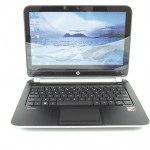 For consumers on a budget, the site’s top pick for 2013 is Hewlett Packard’s Pavilion TouchSmart 11z ($399), which combines a crisp, responsive 11.6-inch touchscreen with good battery life. While it’s not designed for heavy multitasking, offers narrow viewing angles, and is somewhat heavy for an 11-inch notebook, the speedy A4 processor, 320-GB hard drive, and 4 GB of RAM more than make up for those shortcomings, at least for the price.
For consumers on a budget, the site’s top pick for 2013 is Hewlett Packard’s Pavilion TouchSmart 11z ($399), which combines a crisp, responsive 11.6-inch touchscreen with good battery life. While it’s not designed for heavy multitasking, offers narrow viewing angles, and is somewhat heavy for an 11-inch notebook, the speedy A4 processor, 320-GB hard drive, and 4 GB of RAM more than make up for those shortcomings, at least for the price.
Image Is Everything
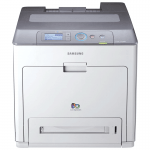 Printers come in a wide variety of price points, depending on the user’s needs for features and performance. Toward the higher side, Samsung’s CLP-775ND Laser Printer ($750) is the current favorite of PC World, which notes that “it breaks no new ground in output quality — photos are a challenge for it, as they are for most color lasers — but it’s fast and well-equipped, and its toner is economical.”
Printers come in a wide variety of price points, depending on the user’s needs for features and performance. Toward the higher side, Samsung’s CLP-775ND Laser Printer ($750) is the current favorite of PC World, which notes that “it breaks no new ground in output quality — photos are a challenge for it, as they are for most color lasers — but it’s fast and well-equipped, and its toner is economical.”
Standard features include automatic duplexing, a 500-sheet main input tray, a 100-sheet multi-purpose tray for envelopes and other thicker media, and a 350-sheet output tray, with room to add up to two more bottom-mounted, 500-sheet feeder trays. On the minus side, the transfer belt — a page-wide plastic band that helps convey toner from the cartridge to the paper — is fully exposed when the printer’s front panel is open, “just asking you to drop something on it.”
Still, with a 600 MHz dual-core processor and 384 MB of memory (expandable to 896 MB), the CLP-775ND posts a fast time of 18.1 pages per minute printing plain text, while color photos come out quicker than average, even though the quality of those pictures is pedestrian.
On the budget end of the printer scale, “the $300 range offers an interesting either/or choice: high-end color inkjets with full feature sets, for small-office or high-end home use, and very low-end lasers for small or home offices,” PC World notes. “But note that, while you can get a pretty nice monochrome laser for $300, a like-priced color model will be slow, lacking in features, and expensive to replenish.”
 That said, the magazine’s top pick in this range is HP’s Officejet Pro 8600 Plus ($300), which boasts speed, at 13.2 pages per minute of plain text, and quick performance with printing photos, copying, and scanning. Meanwhile, features include universal automatic duplexing for copying, scanning, and printing, and full support of legal-size paper.
That said, the magazine’s top pick in this range is HP’s Officejet Pro 8600 Plus ($300), which boasts speed, at 13.2 pages per minute of plain text, and quick performance with printing photos, copying, and scanning. Meanwhile, features include universal automatic duplexing for copying, scanning, and printing, and full support of legal-size paper.
However, it can’t print on a CD or DVD, and its touch controls can be slow to react. Still, it does print from a smartphone or tablet, or from a remote location, through HP’s free ePrint service.
 Speaking of photos, digital cameras continue to evolve at a wide variety of price points. For those willing to foot the bill, PC Magazine highly recommends the Fujifilm X100S ($1,299), the follow-up to Fuji’s groundbreaking X100 digital camera.
Speaking of photos, digital cameras continue to evolve at a wide variety of price points. For those willing to foot the bill, PC Magazine highly recommends the Fujifilm X100S ($1,299), the follow-up to Fuji’s groundbreaking X100 digital camera.
The camera, like its predecessor, boasts a retro design, as well as a hybrid viewfinder system that can toggle between a big, bright optical view and an electronic viewfinder, as well as a fast lens with a 35-mm (full-frame equivalent) field of view. “The sensor has been upgraded to a 16-megapixel X-Trans CMOS design that is capable of producing some incredible results at extremely high ISO settings, and a notoriously sluggish autofocus system is now a reasonably quick one.”
 For significantly less money, PC Magazine called the Olympus Tough TG-2 iHS a solid option at $379. Like its predecessor, the Tough TG-1 iHS — which the magazine described as “a compact shooter with a fast lens that could shoot deep underwater and survive drops, pressure, and extreme temperatures,” while taking great photos in all types of light — the new model makes a few modest upgrades at a lower price. “We haven’t seen another rugged camera that could challenge the TG-1,” it noted, making the TG-2 the logical choice for 2013.
For significantly less money, PC Magazine called the Olympus Tough TG-2 iHS a solid option at $379. Like its predecessor, the Tough TG-1 iHS — which the magazine described as “a compact shooter with a fast lens that could shoot deep underwater and survive drops, pressure, and extreme temperatures,” while taking great photos in all types of light — the new model makes a few modest upgrades at a lower price. “We haven’t seen another rugged camera that could challenge the TG-1,” it noted, making the TG-2 the logical choice for 2013.
Joseph Bednar can be reached at [email protected]
Jeremiah Beaudry Colors in a Successful Story of Entrepreneurship
By MICHAEL REARDON
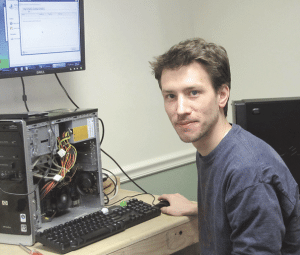
Jeremiah Beaudry took his youthful passion for computer repair and turned it into a successful business.
By the time Jeremiah Beaudry was 10 years old, he was building computers.
By the time he was 14, he was running his uncle’s computer repair shop, and by the time he turned 15, he had started his own computer business.
Call him a prodigy. Call him a wunderkind. The bottom line is, the owner of Bloo Solutions in Chicopee knew exactly what he wanted to do in life, and was very good at it from a young age.
“My uncle, Len Beaudry, had his own computer shop in Leominster called Computer HMO,” Beaudry told BusinessWest. “He would drop off broken computers at our house, and my Dad would put them in the basement, and I would go down there and play with them. They were like Lego sets to me.”
When he was 13, Beaudry worked summers repairing computers in his uncle’s shop. The next summer, he ran the business while Len was away. Beaudry mostly taught himself about computers, as he scoured the Internet for instructional videos and any other resources he could find.
“I broke things constantly,” he said. “I’d spend days figuring out what I did wrong. I learned by getting my hands on it and why I did what I did.”
At 15, he opened his business, initially called CBOS Computers, out of his basement at home.
“It was a silly name; it stood for Can’t Beat Our Service,” Beaudry said with a chuckle.
Beaudry, now 30, recently sat in his small computer shop on Grattan Street in Chicopee, surrounded by computers in various stages of assembly and repair, to talk about his business and his formula for success. He was relaxed in blue jeans and a T-shirt, and takes a genuine interest in other people, asking a visitor how he got started in his business.
The choice of the name Bloo Solutions, with the unconventional spelling of the word ‘blue,’ was simple. Beaudry loves the color and designed many websites using different variations of blue. When he went to register the domain name, he found another company called Blue Solutions existed, so he simply changed the spelling.
The venture has carved out a niche as a resource for small businesses throughout the region seeking information-technology solutions. Beaudry provides a wide range of services, including website design, repairs and troubleshooting, virus removal, network and security setup, and more.
He has also offered advice to clients on the right computer or entertainment center to buy, and even on how best to market their products or services.
“What I like most is solving problems for people,” Beaudry explained. “I like to know I’m doing something to make a positive difference in somebody’s business.”
Web of Intrigue
A native of South Hadley, Beaudry graduated from South Hadley High School in 2001. Before earning that diploma, though, he was earning a salary with his own business, one focused mostly on repairing computers owned by clients of his father, an independent financial manager.
“I learned a lot … they were patient with me,” he said, adding that having a father who worked for himself had a big influence on him. “Having flexibility is more important than having stability sometimes.”
In the beginning, Beaudry would make cold calls to area business owners trying to grow his client roster. In 1999, he scored his first big website-design job when he was hired by Tekoa Country Club in Westfield.
“I got a $4,000 contract to do their website,” he said. “It was unbelievable to me. Since then, I’ve never advertised. Business has been all word of mouth. It’s grown organically.”
Beaudry took a break from the business to attend Bentley College in Waltham. While at school, he worked at a local Radio Shack, which he hated. Indeed, that experience only reinforced his resolve to work for himself and enjoy both the freedom and responsibilities that come with being an entrepreneur.
“I was working someone else’s schedule,” Beaudry said of his time at Radio Shack. “It was the same thing every day. I wasn’t helping anyone; I was just selling things. I probably lasted there only four to six months.”
Bentley College didn’t take either. Beaudry found a client in Hingham, a retail store called Beauty and Main, that was expanding and needed help with updating its computer system to accommodate the move.
“They expanded from one to eight stores, and my job was to install software in all of their stores all over New England,” Beaudry said. “They were 80% of my revenue. I had a couple of people working for me at the time, helping with that project.”
That’s when Beaudry decided to leave Bentley behind and move back to South Hadley. He worked out of his house for 10 years before getting married and starting a family. Beaudry, his wife Chelsea, and son Daxton, who was born in June, live just over a mile away from his shop.
“Having a home office did the trick for a long time,” he said. “But then you start a family, and the office becomes the baby’s room. Plus, I needed a place to meet clients or where they could drop off their computers.”
Bloo Solutions has been at the Grattan Street location for about three and a half years. Beaudry has one employee, his South Hadley High School friend, Joshua Charland, an IT consultant, and more than 100 clients, about 25 of them steady.
“We try to be a one-stop shop,” Beaudry explained. “We target small businesses. We can be their outsourced IT department; they can come to us with all of their questions.”
Chicopee attorney Robert Lefebvre of Gelinas & Lefebvre has been a client of Bloo Solutions for about 10 years, from the time he met Beaudry through a marketing group. At the time, his four-attorney office needed help replacing equipment and updating its system. Since then, Beaudry has been like the office’s own IT department.
“Jeremiah has provided many services for us,” Lefebvre said. “He’s been phenomenal in helping our practice.”
The services provided by Bloo Solutions to Lefebvre’s law firm have evolved over the years to everything from designing the website to updating equipment; from installing backup systems to online marketing, and more.
“Jeremiah is indispensible,” Lefebvre said. “I’ve referred him to many different clients and businesses, and they’ve gotten the same great results that we have. For what he does, you usually have to hire a larger company that would cost you much more money. He provides a unique service to small companies.”
According to Lefebvre, what really impressed him about Beaudry was his commitment to getting to know how the law firm was run so he could better determine exactly the kind of services it would need.
“He’s reliable,” Lefebvre said. “He would research what other, similar firms are doing on issues involving security, and he would come back with recommendations so he could adequately structure our systems.”
Another Chicopee client, A. Crane Construction, retains Bloo Solutions for several IT projects, including the redesign of the company’s website, social-media marketing, IT solutions, and other work.
“Jeremiah is extremely detail-oriented,” said A.J. Crane, owner of the company. “He’s very serious about his business, which is not a common trait among many young business people. He treats his business like we treat ours. He’s very personable, very respectful.”
If Beaudry doesn’t have the answer, he has other experts he can recommend to do the job, he noted. And he is willing to refer his clients to someone who can help with a problem that is out of his area of expertise.
“He always finds the solution for us, even if it doesn’t make money for him,” Crane said.
Technically Speaking
Beaudry told BusinessWest that he’s diligent about keeping up with the ever-changing high-tech landscape. Computer viruses and other destructive bugs are getting more sophisticated and stealthy, and that keeps him busy educating his clients and installing or updating preventative solutions.
“One of the biggest things we do is to make sure clients’ network and security protocol are consistent so viruses won’t infect their computers,” he said. “It’s important to put protections in place so that, if a virus gets into your system, you won’t have much downtime. Downtime costs money, so we try to minimize it so you’re up and running in hours, not days. Nothing is more vital than having backups to your computer system.”
By providing such solutions, Beaudry has kept his clients from feeling blue — or, in this case, bloo, which has become the color of success.
Innovative Business Systems and TechCavalry Simplify Clients’ Access to Information

TechCavalry, acquired in 2012 by Innovative Business Systems, allows Dave DelVecchio and his staff to assist small businesses and individuals with their IT issues.
Racking their brains at 2 a.m., the students did the only thing they knew how to do back in 1989: they called local radio DJs, and after a few attempts, they found one who knew the character’s name (it was Cameron).
Fast-forward 25 years. Just last month DelVecchio was at Fenway Park, and a friend asked where a particular player hailed from. Within 20 seconds, DelVecchio picked up his smartphone and found the answer on Google.
Google — a word that would have drawn blank stares in 1998 — is not only the name of the world’s most ubiquitous search engine, but also a verb; people spend major portions of every week ‘Googling’ answers to questions of various levels of importance.
DelVecchio’s college example of how much more information people have at their fingertips today is reflected in his favorite saying: “that’s why you have a data plan.”
As president of Easthampton-based Innovative Business Systems (IBS), a 23-year-old IT-solutions company — and the parent company of newly acquired TechCavalry — DelVecchio and his four partners are tasked with finding solutions for businesses and individuals to access data, at home or at work.
Through IBS specifically, DelVecchio and his team can provide expertise and resources to meet a client’s information-technology needs, or operate as the IT department’s best resource.
Offering examples, DelVecchio cited a local bank that IBS helped cut server recovery time from eight hours to 45 minutes, and a local nonprofit for which the firm helped move an underperforming peer-to-peer network to a server-based environment complete with mobility solutions.
Additionally, since acquiring Northampton-based TechCavalry in 2012, IBS has grown from 13 to 27 employees and, through that new entity, can provide individuals and smaller businesses (50 employees or fewer) with project-based IT solutions to retrieve their data and protect it cost-effectively.
“It was an opportunity for us to position TechCavalry to serve an underserved segment of the market,” said DelVecchio. “All these technology advances have provided new and sometimes far-more efficient ways to get access to information. It’s not about turning the screwdriver and fixing the problem; it’s about providing consultative analysis and weeding through all the options to make the smart choices for a business.”
For this issue’s focus on technology, BusinessWest talked with DelVecchio to learn more about how he and his team have grown IBS, and now TechCavalry, and how both firms help business owners and individuals cut through the advertising clutter to find the best data solutions.
Next Generation
DelVecchio was a marketing graduate fresh out of college when he landed his first marketing job in 1994 with Bill Tremblay, the former owner of IBS, and on the first day of work had to be shown how to use a mouse.
DelVecchio, who jokingly said he’s now mastered the mouse, often uses a quote from Tremblay, from whom DelVecchio and his four partners later purchased the company in 2003: “computer hardware is the necessary evil to run the software that runs your business.”
As he talked with BusinessWest, DelVecchio explained that Tremblay, an IT project manager at Kollmorgen, started a small software-development company in 1987 and incorporated in 1990. His philosophy was that the company was supporting not just technology, but the user experience.
After working under Tremblay for almost a decade, that user-experience vision is the same for DelVecchio and his partners, who include Vice President and Treasurer Brian Scanlon, as well as Scott Seifel, Ben Scoble, and Sean Benoit.
DelVecchio, who advanced from marketing assistant to president and owner, is not alone in his non-technical background. Most of the staff at both IBS and TechCavalry came from myriad backgrounds, which allows them to effectively relate to a wide variety of client businesses.
Having three of the five partners literally rubbing shoulders with customers and clients is one of the benefits of working with IBS and TechCavalry, said DelVecchio, which also quells one of the biggest complaints in the IT service industry — consultant turnover — due in large part to the fact that Seifel, Scoble, and Benoit are active members of the technical service team, and add a sense of stability to both companies.
“It also helps us to recruit and retain non-partners, because those that come in realize that we’re all in this together. If you want to say the inmates now run the asylum, we were once the inmates,” DelVecchio said with a smile.
As they grew IBS, they found that Western Mass. is home to many smaller companies that didn’t necessarily need smarter technology, but they needed things quickly. DelVecchio said businesses have fewer options for those emergency calls because most growing IT firms won’t handle the ‘little guys.’
Enter Jef Sharp and Jeff Hausthor — serial entrepreneurs who had created nine businesses in a little over a decade — who had launched TechCavalry in 2002 out of a small garage in Florence. With their other businesses growing simultaneously, both owners felt that they needed experienced assistance to manage their small firm, and DelVecchio was approached to consider management duties.
Like the cavalry whose presence is announced with brass fanfare, TechCalvary boasts a trumpet logo and the tagline, “PC troubles? Help is on the way!” That focus appealed to the five partners at IBS, who felt that TechCavalry had a solid niche in the personal-consumer market with excellent growth potential, but that both parties would be better served if IBS owned the business.
“One of the biggest values in TechCavalry was their name in marketing,” said DelVecchio. “Who are you going to call when you need an emergency fixed? You’re going to call in the cavalry.”
In August 2012, IBS acquired TechCavalry and combined the two firms in its Easthampton location. Now, in one expanded headquarters, the company hosts IT user group meetings, lunch-and-learn events, and technology-showcase events, with potential for future expansion on site.
Customer Centric
It was just three years ago that the IBS team decided to segue away from Tremblay’s software-development focus and center on providing IT services and consulting through PC sales, data analysis, networking, hardware and software support, repair, and maintenance.
With the new Windows 8, iPhone OS5, and a thousand other bells and whistles that keep business owners wondering if and how they should invest in technology, IBS and TechCavalry help customers figure out the best fit for their business needs.
“A lot of companies put out a lot of technology because they’re trying to make a buck,” DelVecchio said. “What we do is determine which technologies might be relevant for our clients.”
Cost isn’t always the main factor, he added, noting that his firm has talked clients out of overly complex and expensive solutions as often as it has guided them away from inadequate ones.
The clients that understand the role of technology in business, he said, are the ones that yield the most positive outcome. As a real-world example, he cited a potential new client whose major grievance was the collective 90 minutes of productivity he was losing each day being interrupted by employee complaints regarding their own loss of time due to slow or inefficient technology.
“For him, it wasn’t about technology, and it wasn’t about shaving pennies; it was specifically about how we as a company could add value to their business by helping the owner regain that five to eight hours a week worrying about technology and focus on running the business,” DelVecchio said. “Having a business owner who is an actively engaged participant — and wants the right technology and dollars to be spent in the right places — makes the engagement much easier, and they get real value out of their investment.”
Emerging Field
Where technology is going to lead the business world in the next 10 years isn’t fully defined, said DelVecchio. The challenge for business owners is to not get distracted.
“There is never a panacea that is your solution to every problem,” he added. “Ultimately, it’s about using the right technology for the right reasons.”
DelVecchio’s goal for both firms is to grow in organic fashion — slow and steady — to be able to maintain the deep time commitment clients require.
“All the advances of technology have provided new and sometimes far more efficient ways to get access to information,” he said, “and all we’ve been asked to do as a company, from day one, is to help provide that conduit.”
Elizabeth Taras can be reached at [email protected]
VizConnect Takes Mobile Marketing to New Heights
Ed Carroll says businesses, salespeople, or entrepreneurs who are not advertising on mobile devices are losing customers, and his claim is backed up by many studies, including a survey showing that more than 86 million people sought business information last year via their smartphones.The co-founder of VizConnect in Springfield first became aware of the trend in 2004 when he was working as a television newscaster and Facebook began to gain in popularity. “I saw a paradigm shift taking place away from mainstream media, and one night I began thinking about how businesses could use it because they are completely underserved in that area,” said Carroll, who eventually came up with the idea for the high-tech company he started in 2011 with sales and marketing guru Brian Dee.
The company’s product, a video-based mobile marketing platform, is designed to help small companies or businesspeople keep pace with changes in the way products and services are marketed today.
“Large companies have staffs and people who keep track of trends, but 80% of the economy is small businesses, and they don’t have the budget to do what they need to do to compete in the mobile scene,” Carroll told BusinessWest. “There has been a huge shift to mobile marketing, and everyone in business needs to think about how to get their message onto a mobile device.”
VizConnect has grown quickly, and today is operated by a team of partners who oversee more than 400 distributors. The product they sell has been test-marketed and improved since it was introduced to the marketplace, and most of the distributors came on board in the last six months when the company took steps to grow its sales force, due to enthusiasm about the software.
When people scan a VizConnect QR code or text message a keyword with a code, they come face to face with options that allow them to watch a video, download a coupon, view items on sale or a customer testimonial, learn more about a product or service, communicate directly with the seller, or buy the product. They can access these with a simple click, and after they watch a video, their screen changes, giving them the option of clicking again to share it on Facebook, Twitter, or LinkedIn; calling the company; making a purchase; or anything else the business elects.
“Right now most QR codes go to a static website; we have made them more dynamic,” Carroll said. “Our platform was designed to be a call to action.”
He explained that what comes up on the screen after someone texts to a keyword or scans a QR code can make or break a sale. “Research shows it takes the human mind about six seconds to decide whether to stay or go. It’s a yes or no,” Carroll said.
He added that businesses that fail to use simple techniques to engage customers on mobile devices will soon be left behind. “This is the 21st century, and it’s all about mobile.”
Dee agrees. “Studies show that people never get more than three or four feet away from their mobile devices, and where they get their information drives their decisions,” he said.
VizConnect’s platform costs $60 a month and allows clients to market their products or services in different ways to different audiences, which can include messages in more than one language.
The common denominator is that a customer is immediately given choices. They can click on a window that says ‘see more inventory,’ one that says ‘call,’ or another that prompts them to take a different action.
These options are customized and linked to up to 10 QR codes that can show different videos or display different information. “We have simultaneous multi-messaging so people can target a mailer to a Spanish- or English-speaking demographic. It’s a very versatile platform,” Carroll said, adding that it allows companies to capture the cell-phone numbers of people who visit their site.
“They can legally market to them until they text the word ‘stop,’” he explained, as he used his smartphone to demonstrate the sequence of events.
Menu of Options
But as text messaging grew in popularity, they integrated it into the software. “It allows consumers to have a choice,” Carroll said, adding that the majority of people choose the text-messaging option.
Dee agreed, noting that “QR codes have a place, but the jury is still out on them.”
However, they do serve a purpose. Since they can be created in color, many companies are using them as part of their brand. “We suggest that our customers use a QR code with their logo and the words ‘scan or text to’ a designated code next to it,” Dee said.
The text message prompt and/or QR code can be put on a business card, billboard, refrigerator magnet, T-shirt, or the menu a pizza shop staples onto a box. “The menu could sit in someone’s house for a year, and they could scan it every night to get the dinner special,” Carroll said. Codes can also be saved on a smartphone.
And if a QR code is scanned by just one person, then relayed to any form of social media, it can lead to a great deal of exposure. “If a code gets scanned once, it could be viewed more than 1,000 times by someone who has more than 1,000 Facebook friends,” Carroll said.
However, the texting option is far more popular. “It’s absolutely a key concept of our business and the one the majority of people are using,” Dee said, adding that each customer gets 10 QR codes that are married to a keyword and a short code that goes along with each of them.
Whether the customer sends a text message or scans the QR code, it takes them to the same interface. “Texting is an everyday part of American life, so it’s the perfect bridge for a small business to reach their customers on their smartphones,” Carroll continued, reiterating that it can drive them to a coupon, video, or whatever message or video the company or salesperson wants to project.
In addition, these messages can be changed on a daily basis as VizConnect gives clients the tools to deliver, manage, and store an unlimited amount of video.
“Video engages. It creates a response. It works,” Carroll said. “It’s the most engaging medium that has ever been created because it hits all the senses and invokes an emotion whether someone is visual, auditory, or kinesthetic. Everyone who watches will be stirred to do something. It’s easy to create and doesn’t have to be long to be effective.”
Videos can be created at no cost with the client’s smartphone, and even a six-second video is effective.
“The longer it is, the more boring it becomes. And if you don’t like it, it’s easy to redo,” Carroll said as he picked up his smartphone to make a short video of himself talking. “If you have a restaurant and sell cheeseburgers, you can grab your phone and shoot a high-definition video and tell people it’s a great buy. Or you can serve one to someone and have them say, ‘this is delicious. You have to try it.’ Testimonials are the best way of getting new business, as they give you credibility.”
Spreading the Word
Carroll and Dee sold their product door to door for more than a year, all the while ironing out kinks and improving its efficacy. They also chose a select number of people to help them.
But after incorporating texting into the software, they made the decision to go public last November and offered people a way to join the company by becoming distributors.
They hold informational seminars every Tuesday at 7 p.m. in their offices on the 14th floor of the Sovereign Bank building on Main Street in Springfield for potential customers and salespeople, along with team-building conferences and training seminars.
“We have a direct selling platform, and in this economy, people thinking about starting their own business or developing a way to generate extra income can join us,” Carroll said, adding that they have plumbers, firefighters, and law-enforcement officers working for them.
The company also has six partners — four who are local and two in San Francisco. Carroll, an Associated Press and Emmy-award-winning on-air personality, has appeared on local television newscasts throughout New England as well as CBS Evening News, and spent many years producing and appearing in weathercasts, news features, and special programs.
Dee, the company’s secretary and chief sales officer, spent 20 years in sales, with a focus in sports marketing. His career includes managing credit-card marketing programs for MBNA America and Bank of America in conjunction with the Red Sox, Celtics, Bruins, and Patriots, along with many major college sports teams.
President Paul Coleen was a former bond trader on Wall Street, while attorney James Henderson is treasurer and provides the company with legal counsel.
And they say news about VizConnect is spreading fast. Accolades include the fact that the company was named one of the top five technology start-ups to watch by Mass. High Tech and the Boston Business Journal last year.
Moving Forward
As the smartphone industry explodes, Carroll and Dee expect their business to continue growing. “It’s comes down to this: smartphones are where people go to get information to make a decision,” Carroll said.
Dee concurred. “We’re excited about the future as we continue to add distributors across the U.S. and eventually look forward to international expansion.”
Which makes perfect sense, with multilingual options and a product designed to keep pace with the times.
Understand the Dangers of Insufficient Backup Procedures
By SEAN HOGAN
Today’s businesses are operating at a blistering pace, and IT infrastructure has become the backbone of small to mid-sized businesses (SMBs) across the nation. The complexity and strain placed on networks has exposed these businesses to greater security threats than ever before.Natural disasters, power outages, employee errors, and failed system upgrades all pose significant threats to the network, and failing to address these risks can cause severe network damage and immobilize a company for hours, days, or weeks. The best way to combat this dynamic is to understand the risks, address the problem, and make sure the proper precautions have been taken.
One of the risks most easily mitigated is when data simply hasn’t been backed up. Oftentimes, organizations fail to have a regular backup procedure in place, whether partially or completely, and having a data-backup program can help get around this issue.
According to Symantec’s 2011 SMB Disaster Preparedness Survey, “only half [of SMBs] back up at least 60% of their data,” meaning they would lose 40% of their data in the event of a disaster. In addition, organizations often fail to back up corporate PCs, or take an all-or-nothing approach if it can’t be all-inclusive. For example, of those surveyed, 31% don’t back up e-mail, 21% don’t back up application data, and 17% don’t back up customer data.
The biggest benefit to having a process in place is that employees never have to redo work. If data is ever lost, it can be recovered rather quickly and with minimal effort.
Another risk to address is failing to protect branch offices or telecommuters. ‘Out of sight, out of mind’ doesn’t exactly fare too well in the corporate arena. When businesses are subject to compliance or regulatory standards, they must ensure that all company endpoints are protected in an appropriate fashion. When there is a centralized IT support staff, they can often overlook users that are not primarily in the office, as in the case of salespeople, for example.
Failure to consistently back up company data is another common oversight. The benefit of having an automated or regularly scheduled backup is paramount. According to Enterprise Security Group, even with all the advancements in storage technology, only about 20% of backup jobs are successful. This is exactly why consistency and frequency are such key metrics in evaluating any backup solution.
Utilizing outdated equipment such as tape or disk media poses a threat in that these solutions are hardware, meaning they can be lost, stolen, or improperly stored. Any of those situations usually results in irretrievable data, therefore rendering that equipment useless when a recovery is most needed.
Today’s business continuity and disaster-recovery solutions address these risks and provide a software-based solution that virtualizes all data to the cloud. This enhances overall performance by providing greater accuracy, efficiency, security, and archiving functionality to a business’s disaster-recovery plan.
Simply put, technology has come too far for businesses to have to deal with the notion of losing important data and risking going out of business. With today’s powerful solutions and the assistance of a trusted IT advisor, SMBs can protect themselves, their employees, and their customers’ data from these threats.
Sean Hogan is president of Easthampton-based Hogan Technology, a business-technology company that specializes in increasing customer profitability and efficiency through the use of technology www.teamhogan.com
Concrete Goals Are Critical to Designing a Successful Website
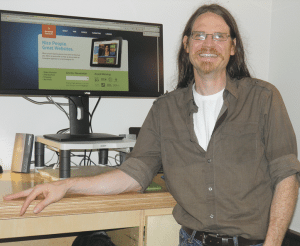
Jason Mark of Gravity Switch says search engine optimization is important, but there are markets where it is impossible to rank high on a search list.
“Even though there is so much different technology that developers can use today, the exact same process still needs to take place,” said the co-founder of Gravity Switch in Northampton. “People need to know what their goals are, and businesses should not assume that technology will fix all their problems. If it were that easy, their competitors would have already done it.”
Experts agree that, in order to create a successful website, the developer needs to know exactly what a business wants to accomplish because, without that information, it becomes impossible to calculate whether the return on investment will justify the cost.
Dan Green, president of the Green Internet Group in Springfield, says the first step involves a diagnosis of the problem a company is trying to solve. “Otherwise, it’s like a doctor giving the same medicine to every patient.”
Many businesses have not kept up with cutting-edge technology, but there is often no real need to do so. “One of my colleagues did a recent study that showed 48% of restaurants don’t have a website,” Green said, adding that it’s possible to have strong Internet presence without one due to social media and other networking tools.
“But the way people search for a business is a critical aspect of all web marketing; you need to know your customer’s intent and what problem they are trying to solve when they type something in to the search bar,” he said, noting, for example, that if someone wants a plumber, what they require differs greatly from someone looking to purchase an automated time clock for their business, which typically involves research.
Peter Ellis, creative director for DIF Design in Springfield, says social media and mobile devices have led to changes in consumer expectations. In the past, many businesses had separate websites for desktop and mobile users, and the mobile versions were often limited to basic contact information. But responsive design has changed the way the industry operates.
“We prepare websites to be intuitive, so they automatically adjust to the size of the device the person is using,” Ellis explained. “The quality and success of a website is based on how it appears to their target audience.”
Lawrence Shea agrees. “There is more and more mobile web traffic every year, and if someone goes on your website and it is not optimized, people may not think you are competitive,” said the owner of Web Wizard in Springfield.
Mark said 10% to 75% of the visitors at many websites are using mobile devices. “If you don’t know how people are accessing your site, you need to find out,” he told BusinessWest, adding that content needs to flow in a way that doesn’t require people to pinch the screen or zoom in frequently.
Ellis concurs, and says social media has shortened people’s attention spans and changed expectations. “People want instant gratification, and if it takes them 10 to 15 seconds to find a phone number or restaurant menu, they may leave the site,” he said.
Google predicts that, by the end of this year, 51% of all Internet traffic will come from mobile devices. However, experts say this does not mean that every business should have a responsive website.
But their site should correspond to their specific goals, and designers say outdated websites often fail to attract new customers because they were not built with a specific purpose in mind.
“In this day and age, just having a website is not enough. The business owner needs to know what they want to communicate, who their customer is, and how they want to present that information,” Ellis said.
In the past, people were willing to hit tabs on a menu to get information. But today, the home page needs to be a mini-version of the entire website. “You need to give the visitor enough information to make a decision without having to navigate to a secondary page,” he continued.
And although social media can play a real role in success and is changing the way businesses interact with their customers, it also doesn’t mean every company needs to be on Twitter or have a Facebook page. “There are hundreds of platforms that should be considered,” Ellis said, adding that experts are knowledgeable about what will work best.
Climate Change
When someone types in words on a search bar, they are apt to call up the first websites listed by the search engine. But getting a top spot is not easy, and Ellis says many variables are involved in search-engine optimization, or SEO. They begin with how a website has been built, since search engines dramatically change the way they operate every three to six months. For example, Google started requiring a certain number of words on a page, and if a site contains only contact information, it may be deemed less important than others.
Still, having pertinent information on a home page is not enough. “It has to be placed strategically, which depends on what customers are seeking from a business,” Ellis said.
In addition, frequent updates are necessary. “We suggest doing an update monthly,” Ellis said, adding that “the shelf life of the average website is two to three years. A website may look good and work and function well, but not comply with current search-engine criteria.”
Shea agrees and advises companies to choose nine keywords their competitors are not using. And although a small business may not be able to compete on the wb with large companies, it can beat competitors by focusing on the local market, he said.
Green calls matching content to customer intent “context mapping,” and says the return on investment for businesses seeking leads that result in a purchase can take more than a year if their product costs thousands of dollars, which makes it critical to recognize the phases involved in decision making, which are very different for a coffeemaker and an automobile. “People really need to think about how complex the sale is, how competitive the marketing is in their industry, who they are selling to, and what they are selling,” he said. “These things must all be considered before you can design a website that is effective. It’s easy to create one that is pretty, but what people are seeking is a desirable outcome.”
So, although design, function, and content are important, small businesses may need to employ a different marketing strategy when competing for customers via the Web.
Ellis has a client who specializes in foreign car repair, and his strategy is to identify specific work he does, such as repairing BMW exhaust systems. “It’s absolutely critical to have a strategically designed website to be competitive. But there is no road map to success. There is just knowledge, best practices, and things to avoid. It is a journey that needs to be developed between a customer and a web designer based on overall goals and strategies,” he said.
Once a website is operational, it’s important to access the data connected to it. But although Green and other experts say statistics are important and many businesses have that information, they often don’t know how to analyze it or what to do with it. “Businesses need someone who can take the data and make recommendations in line with their goals,” he said, adding that companies are often using several marketing tools, so it becomes tricky to determine which one is getting the best results.
But once that has been identified, it can be translated into their website. “Once you have defined your goal or how you want your brand to appear online, you need to execute a plan,” Ellis said.
Mark agrees, and says analytic software is useful in determining how often people visit a page, then leave it. If it’s a high percentage, it means action is warranted. “But it really comes down to math and where to invest for profit. There are definitely cases in which to invest in the Internet, but you need a smart plan, and there are markets you can’t make inroads into by using the Internet,” he said.
In many cases, it is better to refine an existing website and drive more traffic there rather than investing in a new one, Mark added. For example, if a business generating less than $2 million annually is competing against an industry giant, there is an instant return on investment if they update a website that made them look like a mom-and-pop operation. The Internet can also be effective in generating leads, if used properly.
“We can consistently get people leads at almost half the cost of other methods, and those leads are better-qualified,” Mark said. “But it’s all about math, and people should not have their website redesigned until they understand how it will add value. It should never be done just because it is out of date.”
Effective Measures
Many business owners are concerned about the program a developer is going to use for their website. Mark said more than 75% of the top 1 million websites in the world run on WordPress, Drupal, or Joomla. “All three are very powerful, stable, and well-supported. In my mind, there is no reason to use anything but those three.”
Shea added that fads, such as using ribbons on a site, tend to have short lifespans, so it’s important to stick to things proven to improve the user experience. His specialty is e-commerce, and he says people using mobile devices often access a website because they want to make a purchase, so listing prices is useful.
“People will pay for branding and convenience, especially if they can do one-click buying,” he said.
However, security is critical for businesses engaging in e-commerce. “The last thing a company needs is to have their site hacked,” Shea said.
Social media can also play a key role in marketing. But some strategies are more effective than others, so knowledge is key. For example, the number-one reason people don’t open an e-mail is because they don’t recognize the sender, Ellis said.
Shea says a plug-in tool, such as the free Mail Chimp (for people who send fewer than 2,000 e-mails per month) may be needed to maintain a professional appearance and keep responses organized. However, rules must be adhered to even in this realm, because more than six e-mails sent to the same user each month can be dubbed as spam.
Green said blogging is another effective tool that is often left out of the mix. However, posts must be made frequently and must contain fresh content.
“It takes time, but if you put in the effort, it will pay off,” Shea added.
But, again, strategy depends on goals. “What’s right for your flower shop might not be right for the shop across the street from a college,” Green said.
Business owners may also not be aware of praise or criticism regarding their company on Facebook or other sites. “Most people have comments about their business on the Internet they don’t know about,” Green noted.
Ellis agreed. “It’s important to know both the positive and negative and filter them through your goal,” he said.
Green told BusinessWest that knowing whether or not to react to a post is important. “If someone says something bad about a business and has a small Internet presence, it may go away. But if you jump on it, it may escalate,” he said, adding that, if a business is not well-run, social media will amplify the negatives.
He advises business owners to study negative comments because the feedback can be valuable. They also need to know the statistics before launching a social-media marketing plan. “It’s very complicated to figure out the return on investment with social media. You can do well if your audience uses it, but you have to be honest, interesting, and run a reasonably good business.”
Still, only 5% of online business leads result from this medium, so focusing on other issues, such as the strength of one’s sales force and the search engine a website uses, may prove more fruitful.
However, good writing is something that makes a real difference, especially since a business has only three to five seconds to capture someone’s interest. “The most highly viewed content is the headline,” Green said. “But if you don’t have a starting point and a key-performance indicator that you plan to measure, it’s difficult to define success or know what to do in terms of improvement.”
Shea concurs. “Content is key, but presentation is also important,” he said. “It’s the first impression people have of your business.”
Bottom Line
Although some business owners feel pressured to update their website and use social media, Green said, it may not be relevant to their goals. “You need to measure what you are doing to determine if you are making progress.”
Mark agrees. “Think forward three years,” he advised. “Don’t get caught up in what’s new. You may need to talk to experts to determine the best path, but everything you do should be driven by your goals.”
Holyoke Medical Center Innovates with Shared Patient Information

Carl Cameron says the future of healthcare IT is the instant sharing of information among different providers, and HMC is busy developing that connectivity.
As director of Information Technology at Holyoke Medical Center, he understands better than most the trends and government mandates that have begun to collide like tectonic plates in his industry — forever altering the medical landscape.
Fortunately, he said, HMC has been well ahead of the game.
Take, for example, the Healthcare Information and Management Systems Society (HIMSS) and its data-analysis arm, HIMSS Analytics, which tracks the progress of healthcare organizations toward meeting federal mandates for electronic health records (EMR).
“They are the organizational IT group for healthcare,” Cameron explained, “and six or seven years ago, they determined how hospitals are rated with implementation of EMR and how that ties into patient safety and improved outcomes. They start with stage 0 — basically very little automation at all — and go up to stage 7, a complete electronic record throughout the hospital.
“We were recently validated as a stage-6 hospital,” he continued, adding that there are only 15 such institutions in Massachusetts, and only 11% of all U.S. hospitals rate at stage 6 or higher, “so just being in that category kind of puts us ahead of where most hospital systems are.”
That effort has encompassed several fronts, from HMC’s adoption of computerized physician order entry in 2009 — three years before the state required it — to a switch from paper chart entry to doctors using computer tablets when interacting with patients.
Perhaps most ambitious, though, has been the hospital’s partnership with EMR vendor eClinicalWorks and its progress in connecting patient records with community physicians outside the hospital.
“One of the projects that we’re in the process of implementing — one that puts us a little bit ahead of others — is our health-information exchange,” Cameron said, explaining that 40 community doctors were initially recruited into the system.
“We’re also working with Holyoke Health Center [HHC] to bring an additional 30 providers on board connecting to the health-information exchange,” he added, noting that additional plans are in the works to connect 30 providers from River Valley Counseling, where behavioral-health patients are referred from HHC.
“This kind of closes the gap in terms of episodic care,” Cameron said, noting that, traditionally, “if a patient visits a physician or the ED, they document it, and the information stops there; it’s not shared across the continuum to other caregivers involved in that patient’s care.”
By creating a health-information exchange, he explained, the hospital reduces the chance of diagnosis or treatment error by making information about a patient’s last primary-care visit, current medications, recent procedures and test results, and the like immediately available to whomever happens to be treating them.
“So, if I walk into the emergency room today and I was at my primary-care office three weeks ago,” he said, “the ED physicians can see what I was there for, what medications my primary-care doctor prescribed, any new medications, if I have any allergies, those types of things.”
Drawing Interest
Cameron was quick to note that patients are not required to participate in the exchange, but the vast majority do. “We have a whole patient-consent process where patients must opt in, but the opt-in rate is around 93%.”
And the exchange could grow to include more than just written records, he added.
“One thing that’s going to set us apart over the next six to 12 months is the ability to add imaging results through the exchange — not just being able to see the patient information, but diagnostic images that have been taken.”
The exchange will also eventually help the hospital with public-health tracking and reporting, Cameron said. “Because the health exchange is going to become the repository of information, it will enable us to do population health reporting. For example, how many diabetics are there in the community, and are they following up with their patient care? It really allows us to manage chronic diseases better.”
A robust health-information exchange makes sense especially against the backdrop of the nascent accountable-care model of healthcare delivery, by which several providers in the community take joint responsibility for a patient’s long-term care.
“We see the health exchange as a foundation — that’s what we’re doing, setting the foundation for these other initiatives,” he told BusinessWest. “Very quickly we anticipate being up over 100 physicians in the health exchange, and we only went up with this in November, so we’ve made some good traction.”
The end goal, Cameron said, is to share information among various healthcare institutions. “I see that happening in multiple ways. I see us forming partnerships with other hospitals to create connectivity or expand the highway, so to speak, and I see the state as an important partner as well, to create that connectivity beyond the local borders in Western Mass.,” he explained, citing the example of a patient in Springfield with a cancer diagnosis who seeks a second opinion or specialized treatment in Boston.
“I think we’re a ways off from that, but we’ve taken the first steps with the state,” he said, noting that he is also working with a colleague in Illinois on testing the functionality of health-information exchanges across state lines, and researching how state and federal laws would govern such an effort.
Easy Access
Patients will soon benefit from EMR in other ways, too. For example, Holyoke Medical Center will roll out its ‘patient portal’ by the end of August, allowing patients to access their hospital records online.
“That’s new, and that’s coming,” Cameron said. “We’ve actually rolled that out internally to employees as a way to get feedback. We’re helping our vendor to develop it and make changes to the product.”
He recognizes that this brave new world of shared and accessible information is a shock to the system for many — not just patients, but providers, too.
“Physicians are all overwhelmed with this push to electronic health records, so we’re working very hard to create partnerships with physicians, to create ease of use and efficiency. We’re trying to help them transition from the old way of practicing to what the new way is going to be.”
He conceded that many physicians are anxious and feel like EMR is being forced on them. “But it is going to help improve healthcare. It is going to make the system more efficient — but it’s going to take some time.
“The way I try to articulate it is, banking and manufacturing have all had IT systems for 30, 40 years,” Cameron told BusinessWest. “On the clinical side, we’re in healthcare IT 1.0. We’re very early in the process. There are going to be bumps in the road, but we have to work together to fix them as we move forward.”
At the end of the day, he said, “I don’t lose sight of the fact that, yes, we’re doing a lot with technology, but it’s all about patient care, patient safety, and improving outcomes.”
Joseph Bednar can be reached at [email protected]
How to Manage the Minefield of Electronically Stored Information
“They say I’m old-fashioned, and live in the past, but sometimes I think progress progresses too fast!” — The Lorax, Dr. SeussWe live and work in a digital age. More than 89 billion corporate e-mails are sent and received each year, and more than 300,000 pages of text can be stored on one computer alone.
Electronically stored information (ESI) comes in a multitude of different file types and formats, including, but not limited to, e-files or electronic documents that exist on a user’s hard drive, a network drive, or a document management system; word-processing documents, such as Word or RTF; PowerPoint presentations and Excel spreadsheets; graphic files, such as PDFs, TIFs, or JPEGs; web pages or web-based data; video or sound files; server or web based e-mail; and Outlook/Exchange. ESI may be stored duplicatively as well; for example, an e-mail may be stored in Outlook and on that same user’s BlackBerry or iPhone.
The volume of ESI continues to grow and multiply rapidly just in the course of ordinary business operations. Because of the sheer and ever-expanding volume of ESI, storing and managing it can be extremely overwhelming, costly, and burdensome for businesses. Yet, not properly storing and maintaining certain ESI may present legal liabilities.
To ensure that necessary ESI is being maintained and that unnecessary ESI is being purged, companies should implement a comprehensive document retention-and-destruction policy that specifically addresses ESI. Presently, many companies may not even have a formalized written plan that describes how and where their paper documents will be stored and when they will be destroyed, let alone addresses the storage and destruction of ESI. In fact, since having such a policy is not mandatory, for many companies, less-formalized standards, which have not been memorialized in writing, have evolved over time as a matter of practice.
Establishing a written comprehensive document retention-and-destruction policy is a best practice for two primary reasons: legal compliance and legal defense. In our digital age, because many documents are electronically stored, establishing such a policy that also specifically addresses the storage, retention, and destruction of ESI is crucial. Indeed, ESI presents unique challenges because of its volume and the difficulty in accessing and retrieving it.
From a legal-compliance standpoint, there are myriad laws that mandate the types of documents that must be retained, the ways in which they must be stored, and the length of time they must be kept. For example, wage-and-hour laws require businesses to maintain certain payroll records containing information such as the employee’s name, address, Social Security number, and job title and the hours worked and amount paid to that employee for each pay period. In an increasingly digital workplace, this type of payroll information may only be stored electronically.
Accessing and retrieving that information, and otherwise ensuring its preservation, is critical to demonstrate compliance should a company face a federal or state governmental audit. Furthermore, privacy laws require that businesses reasonably and adequately safeguard confidential or private information whether it is stored in paper or electronic form. Thus, a formalized written policy should account for these as well as a variety of other issues and detail the ways in which the company intends to comply.
From a litigation-defense standpoint, companies have a legal obligation to preserve all relevant documents if litigation arises or if litigation is threatened. In other words, once a lawsuit is filed or anticipated, companies cannot lose or inadvertently destroy documents that are germane to litigation. Therefore, not having a document retention and destruction policy that specifically addresses ESI when faced with litigation or the possibility of litigation can have devastating consequences.
For example, if a former employee’s attorney requests relevant ESI that cannot be accessed or retrieved, or was otherwise deleted, a court may determine that there was a failure to preserve such relevant information and impose severe penalties and sanctions against the company.
To minimize the risk of inadvertent deletion of ESI, a company’s document retention-and-destruction policy should contain two essential provisions: a litigation-hold provision and a departing-employee provision. A litigation-hold procedure ensures that the requisite steps are taken to preserve relevant documents. A carefully crafted litigation-hold section will identify the triggers for a hold on documents, the steps to be taken once a hold has been initiated, the types of records and data that must be preserved, and the forms in which such records and data must be preserved, the consequences for failure to preserve such data, and the name of the person at the company who can be contacted with questions or for technical assistance.
Procedures regarding the length of the retention of a departing employee’s ESI should also be included in a document retention-and-destruction policy, even when litigation is not anticipated. Too often, an unexpected lawsuit ensues, and it is discovered too late that a former employee had created ESI pertinent to the company’s defense. Indeed, oftentimes, within days after the employee’s departure, IT has reset the former employee’s computer so that another employee can use it. Thus, creating a policy that includes a set time period for the deletion of a departing employee’s ESI when litigation is not anticipated is very important.
Having a set time period can otherwise be beneficial, especially for those companies that tend to retain anything and everything. Consider, for example, a snarky e-mail that has been kept too long and now surfaces in litigation that otherwise was not expected or anticipated. If the company had a document retention-and-destruction policy that included a specific time period for deletion, such an e-mail would have been long since gone.
A carefully crafted document retention-and-destruction policy can otherwise be advantageous to companies insofar as it helps to reduce costs, eliminates the retention of redundant or unnecessary documents, maximizes computer-server storage space; and provides organized and streamlined systems for maintaining and managing documents.
Keeping paper documents organized and maintained is relatively easy; however, as noted throughout, the same is not true for ESI. Preserving ESI is very complicated and requires extraordinary coordination between upper management, human resources, legal counsel, and IT.
To minimize your company’s legal risks, you should act now by creating a formalized document retention-and-destruction policy that incorporates standards for safeguarding and disposing of ESI.
At implementation, you should train your staff to ensure they understand the policy and their relation to it. After implementation, you should periodically audit your company’s overall compliance with the policy.
Amy B. Royal, Esq. specializes exclusively in management-side labor and employment law at Royal LLP, a woman-owned, SOMWBA-certified, boutique, management-side labor and employment law firm; (413) 586-2288; [email protected]
The Effect of ‘Bring Your Own Device’ on Today’s Businesses
By CHARLIE TZOUMAS
But despite the potential cost savings in not having to purchase and maintain expensive computer equipment, this new shift to BYOD does bring serious concerns about both network performance and security.
In the Beginning
When portable technology first made its foray into the business world, it was typically through the use of company-provided laptops and cell phones, which were intended solely for professional purposes. While these were difficult to maintain and expensive to purchase, they provided each IT department with almost full control over which devices could access a given company’s network.
With the dawning of these devices for personal use, however, employees were reluctant to sacrifice their iPhones, iPads, and Android devices while at the office, which led to the push for BYOD.
As time has gone on, more and more businesses have accepted that their employees will use at least one — and sometimes two, three, or more — personal devices while in the office. It’s easy to imagine that at least one of your colleagues uses a laptop for day-to-day business activities, an iPad to take notes during a meeting, and/or a smartphone while sitting in traffic en route to the office.
On the bright side, this means that IT departments do not need to conduct as much training as they may have once needed to, but this also means that there are increasing security risks and more bandwidth congestion on these networks, which can be far worse of an inconvenience if not handled correctly.
Keeping Tabs on Network Performance
Gartner also stated that 80% of recently installed corporate wireless networks will become obsolete by 2015 due to poor infrastructure planning, and this is largely because of the growth of BYOD and the impact that this influx of devices can have on a network’s performance.
As more and more devices are added to a network, that network logically slows down. If there are enough devices, it can get overwhelmed. An overwhelmed network dramatically affects productivity, causes unnecessary anxiety for everyone involved, and, at the most severe level, can completely shut down an entire company until the situation is resolved.
How can this be fixed? Businesses must ensure that their internal wireless networks can handle these influxes of devices while still delivering the same speed and performance that their employees need to get their jobs done. Cable operators and other service providers carry a majority of the bandwidth responsibility, so choose a communications partner that has a high-capacity backbone that can be easily scaled up or down to mirror whatever needs your business may have. And make sure your provider can do this quickly, as waiting around for weeks to upgrade your bandwidth can have dramatic effects on your bottom line.
Identifying and Eliminating
Security Risks
Since the devices now being brought into today’s office environments are not company-owned, the IT department does not have full control over them, which means that accidental malware downloads or computer viruses are not only commonplace, but can easily spread to an entire company’s network in a matter of seconds.
If these devices do not have the proper security safeguards in place to protect them, they can potentially allow unknown users to access sensitive company data, which puts the entire organization at risk.
How have IT departments been addressing these concerns? They’ve focused on finding ways to limit access to critical data or to verify employee identities when accessing certain devices and applications, data, or other company resources. Software is consistently being introduced to the market — some of it coming from places as unexpected as the cable company, like Comcast’s recently introduced Upware platform — to allow software administrators to set controls so that users cannot access certain programs without prior authorization.
It may seem minor, but these small changes can help to protect your network from a number of security risks, many of which you may not even know you have.
BYOD Is Here to Stay
At the end of the day, the ability for employees to access corporate networks from their personal devices 24/7 does improve productivity and can drive business growth — and when that also translates to less cost, training, and support required on the IT department’s part, it’s unlikely that it will be going away anytime soon.
And that’s good, because Jupiter Research recently predicted that the number of BYOD devices would double by 2014, which means that enterprises really don’t have a choice, since the number of devices already in the hands of their employees makes it relatively impossible for businesses to ignore them. In fact, a large percentage of supporters for BYOD are C-level company executives themselves, who ultimately oversee IT management and push for BYOD programs to be implemented because they, too, want to use their own devices.
This means that IT departments need to invest in a reliable network infrastructure that has the capacity and bandwidth to support this growing trend, and that offers the scalability and security features to accommodate the ever-changing needs of their employees. Doing this will not only make their lives much easier and less anxiety-ridden, but will also help to improve the ultimate longevity of their company.
Charlie Tzoumas is regional vice president of Comcast Business; [email protected]
Report on Innovation Economy Details Opportunities, Challenges
The state’s innovation economy is experiencing three new shifts that present both opportunities and challenges, including the growth of new sectors like robotics and ‘Big Data’ as major economic drivers, according to the annual Index of the Massachusetts Innovation Economy, recently released by the Innovation Institute at the Massachusetts Technology Collaborative (MassTech).
The index benchmarks the performance of Massachusetts in key innovation-economy sectors against nine leading technology states.
“Our innovation economy is both producing new opportunities and facing new challenges. The net outcome is that our innovation economy is growing and supporting our rebound from the economic downturn,” said Pamela Goldberg, CEO of the Massachusetts Technology Collaborative. “Most of our key innovation industries are adding jobs, and newer sectors like robotics and big data are growing at a remarkable pace. There is, however, work ahead to preserve our leadership status as a global hub for innovation.”
Almost 40% of the state’s employment is concentrated in the 11 key sectors of the innovation economy, and employment rose in 7 of the 11 key sectors in the first quarter of 2012. Meanwhile, average annual wages for all innovation industries increased from 2010 to 2011.
The three new shifts identified by the report are:
• New sectors, such as robotics and Big Data, that are growing and emerging as significant economic drivers. Employment in both areas has outpaced that of the entire Massachusetts economy as well as the 11 clusters identified as the innovation economy. Robotics generated substantial gains in employment between 2007 and 2010, and Big Data’s employment grew 21% in that same time period.
• A changing capital landscape. Massachusetts is also experiencing an increase in angel investment, which nearly doubled between 2009 and 2011. Many entrepreneurs are pursuing innovation with smaller capital requirements than in the past, due to factors such as virtualization of company functions. While Massachusetts retained its first-in-the-nation ranking for venture-capital investment per GDP, the dollar amount of venture-capital investment in the state is still below pre-recession levels.
• Competition. Massachusetts retains its position of strength as compared to other leading technology states, but this year’s index reveals that many other states are gaining ground. For example, while Massachusetts ranks second in industry funding of academic R&D per capita, three other leading technology states grew at a faster rate from 2005 to 2010. Analysis indicates that this trend in broad-based growth may be due to the democratization of innovation and entrepreneurship across the country and globe.
“Our innovation economy has become a global calling card for the Commonwealth, and the Patrick-Murray administration’s continued investments in innovation, technology, and life sciences will help keep Massachusetts at the head of the pack,” said Secretary of Housing and Economic Development Greg Bialecki. “The index shows why the administration has called for increasing investments in innovation, education, and infrastructure.”
Added Patricia Flynn, trustee professor of Economics and Management at Bentley University and chair of the Innovation Index Committee, “the index demonstrates the central role the innovation economy plays in jobs, incomes, and long-term economic growth in the state.” However, she noted, “this year’s index highlights why Massachusetts cannot afford to become complacent with its role as an innovation leader, and that now more than ever we need to invest in the state’s innovative people and assets.”
The new edition of the Innovation Index will feature a new, interactive web portal which provides the public with easier access to the information contained within the index, as well as additional charts and data. The web portal also allows for MassTech to update index data throughout the year.
“The index helps us assess where we are as a Commonwealth and informs the debate about where we are headed,” said Patrick Larkin, director of the Innovation Institute at MassTech. “This new index portal makes this data more accessible to all participants in the state’s innovation ecosystem.”
Other highlights from the Index include:
• As of the second quarter of 2012, Massachusetts had the fastest-growing computer and communications hardware sector employment out of the leading technology states, demonstrating the continued vitality of this key component of the state’s tech sector.
• Massachusetts had the highest number of patents per capita in the country for 2011, an increase of 5.4% from 2010.
• Massachusetts’ research institutions attract the largest share of the National Institutes of Health (NIH) extramural research funding per $1,000 GDP among leading technology states.
• Our total science and engineering talent increased 6% between 2000 and 2011, driven by a 33% increase among those who were born outside the U.S. and relocated to Massachusetts during the same period.
In partnership with the Patrick-Murray Administration, MassTech makes strategic investments that help create conditions for innovation to thrive. These include the Massachusetts Green High Performance Computing Center in Holyoke, which helps position Massachusetts as a global leader in Big Data; the Massachusetts Digital Gaming Institute at Becker College (MassDiGI), which supports the digital-gaming sector; a recent spotlight report on the Commonwealth’s manufacturing renaissance; and a new tech-sector internship program launching this spring to support talent retention.
Normandeau Communications Is All About Making Connections
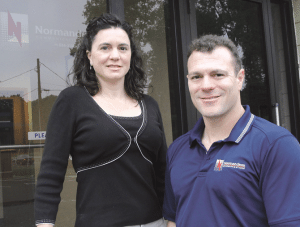
Kim Durand and Brett Normandeau say they strive to match clients with business technologies that, in many cases, they weren’t even aware of.
But there’s more than a hint of gee-whiz in Kim Durand’s voice when she describes some of the technology being installed by Normandeau Communications these days. Take the LG-Ericsson iPECS-LIK product, which manages all kinds of communication — phone calls, e-mails, texts, faxes, etc. — across multiple sites, and even on the road.
“The system processes all calls and does the call management for you,” said Durand, director of sales. “Not only can calls be sent to your cell phone, but voice mails left at your office can automatically appear on your smart phone with the .wav file attached, so you can listen to voice mail at any time. Any time people are on the road and not at their desks, like salespeople, it’s really important for them to be able to do the things they need to do.”
Normandeau has been selling, installing, and servicing telephone systems for 22 years, but voice over Internet protocol (VoIP) technology — which uses the Internet to exchange various forms of communication that have traditionally been carried over land lines — has added elements of convenience unheard of in those early days.
The company’s primary product line, Estech Systems Inc., gives business clients the option of a traditional digital business phone system, an Internet protocol telephony system, or a mix of the two.
But Normandeau is also touting a new patnership with LG-Ericsson, whose iPECS-LIK product further streamlines communication within any size business, from small offices to multi-site corporations with thousands of users, allowing calls to be forwarded between sites and even, as Durand mentioned, to mobile phones.
“We’re also providing surveillance systems as well as loudspeaker paging systems,” said Brett Normandeau, the company’s president and Durand’s brother. “All that ties in very well to your telephone system or your whole communication system. With Web access, I can log in and check the surveillance cameras, tie into the phone system, check e-mails” — all from a distance.
These are certainly exciting times in communications, and Normandeau has tried to stay ahead of the curve as it grows its presence in the Valley. Its visibility was boosted two years ago by a move from Florence to Riverdale Street in West Springfield.
“For us it’s been a convenient spot because a lot of our customer base is located in the Hampden County area,” Normandeau said, “and having acess to Interstate 91 and the Mass Pike makes it more convenient.”
In this issue, BusinessWest sits down with Normandeau and Durand to talk about how these siblings — and the company their father began — is making new connections every day.
New Menu
“Communications is not just talking anymore,” Normandeau said at one point. “It’s the integration of many different types of technology that allows you to communicate more effectively — be it Web sharing, desktop collaboration, instant messaging.”
“We’re taking these technologies,” Durand quickly added, “and merging them into single platforms that are able to offer comprehensive solutions for the customer.”
At its heart, Normandeau commiunications has been trading in phone systems since Ray Normandeau launched the enterprise in Florence in 1990, using money from an early-retirement package offered by a streamlining AT&T.
As Ray built his business on word of mouth and a few loyal customers, Brett started working alongside his father from the start, having been licensed as an electrical journeyman shortly before Ray launched the company. He took over as president when his father retired about 10 years ago.
At the start, clients were mainly residential, but gradually, the emphasis turned to business customers, which today comprise more than 90% of the client base.
“We’ve been expanding slowly since we started with just me and my father,” Normandeau said. “We’re moving into different avenues now. We just opened up a training room to hold seminars.”
That’s an important development, he and Durand said, because technology is changing so rapidly that employers don’t always understand what’s available to help their teams do their jobs.
“It’s technical training, training people on different technologies being brought to market,” Durand said. “These are business customers and commercial clients that might be looking for training on these technologies and how to apply them to their business. We’re really trying to find the right applications to fit our customer base.”
With the LG-Ericsson product, the focus is on consolidating different modes of communication. “It collects all technology — digital, analog, wi-fi, phones — and integrates them all with one solution,” Durand said. “That’s really important when you have multi-site networks with multiple locations, like bank branches or realtors. A lot of different types of businesses can benefit from this type of technology.”
Take the Three County Fair in Northampton, for example, which is now using the iPECS-LIK system to manage communication among seven buildings and across the grounds, while incorporating staff mobile phones and providing options for exhibitors as well.
“Because it’s an old fairgrounds, they have an antiquated communications infrastructure,” Normandeau said. “But because of the technology, we were able to utilize all that infrastructure and bring it up to IP specifications, so they could link it all together. It allows them to use old analog-type techniques and IP techniques in the same system.”
But the technology links sites much more far-flung than across a fairgrounds.
“We’ve gone from very small home offices to large companies with multiple sites across the country,” Normandeau said. “We’re implementing a system to connect an East Longmeadow office with a San Jose, Calif. office. Two weeks ago, we finished one connecting Hartford to Orlando.”
Such new products have allowed Normandeau to expand its reach from the smaller businesses that were long its bread and butter to bigger clients.
“The larger customers are definitely much more accessible to us now,” Durand said. “We’ve been doing this for so long now that we know what the implications are for each business; even if they don’t understand them, we can help them find what the right solution is, by making use of their existing infrastructure and minimizing the costs to the customer. That’s the thing we’ve excelled the most at — offering cost-effective solutions while still providing the technology to see them into the future.”
Knowledge Is Power
On July 18, Normandeau will host a seminar with a representative from LG-Ericsson to talk about the how its communications technology can benefit businesses, especially those with multiple sites. It’s just one of many such events aimed at educating clients — and potential clients.
“Customers in general are becoming more informed,” Durand said. “They’re looking at different technologies, and they do recognize what was not possible years ago is really feasible now.
“It’s really about educating customers so they know what they’re getting,” she continued. “We want people to know what the differences are. We know it’s a significant investment to update technology and phone systems. As a family business, this level of customer service has been really critical for us.”
Added Normandeau, “telephone systems don’t even have to be hardware-based on a customer’s premises anymore. They can be hosted IP systems. We are improving that solution as well, so customers can have an IP phone, but all system connectivity and features are located off-site.”
That option is especially important at a time when disaster recovery and business continuation are on the minds of Western Mass. businesses more than ever, following a year marked by tornadoes in June, tropical-storm flooding in August, and a freak snowstorm and widespread power outages in October.
“We moved a lot of clients, especially in the downtown Springfield area” following the tornado, he noted.
“As soon as it happened, Brett drove down there to try to reach out to our customers,” Durand added. “So many were impacted, with physical damage to their buildings, and communications were lower on the priority list at the moment.”
Still, she said, “it was a very busy year.” And yet another teaching opportunity — and those are, after all, yet another chance to make connections.
Joseph Bednar can be reached at [email protected]
Mobile Web Sites Provide Information Via a Simple Touch
Blair Winans gets many requests from business owners who tell him they want their Web site turned into an app.“I ask them whether they really need an app or whether they just need a mobile Web site,” said the principal and creative director of Winans Creative in Easthampton, which specializes in Web site design and development.
Technology is moving so quickly that, although many people are familiar with these terms, they don’t understand the real differences between them and what they can accomplish, Winans told BusinessWest. They also don’t know what makes sense for their business in terms of the cost/benefit ratio.
“Apps have become a buzzword,” he explained, “But there is a lot that goes into figuring out what someone needs, and it all comes down to functionality.”
Apps cost $20,000 or more to develop, and once they are in use, they are not easy to change. In addition, they must be approved by the iTunes store, then downloaded by people who want to use them, which makes them inappropriate for most small businesses. An idea is viable only if a company wants to provide a service that will become unique to its brand.
For example, a business might want to provide video tutorials that can be accessed via a mobile device, or a real-estate agency might want people to be able to see all their listings on a phone or tablet, Winans said. But many of these things can be accomplished via a mobile-optimized Web site, which is much more cost-effective than an app.
“You really need a high-level strategy to justify an app. Unless you have a revolutionary idea of how to connect with customers, it may not be worth the investment,” said Winans. “There are a million useless apps in the App Store, and if you can’t effectively answer the question, ‘why would someone download this?’ it is pointless to think about developing one.”
Rachael Frank concurs. “Unless your business is the size of Bank of America or Amazon, you probably cannot afford an app that will provide a return on your investment,” said the lead strategist for Gravity Switch in Northampton, which focuses on specialized technology development.
Still, most businesses have fallen behind the times in terms of keeping their Web sites updated, and could profit from technological advances.
“The whole world is playing catchup as Web development and technology has advanced so far in the last five years,” Winans said. “Ninety-nine percent of Web sites are not formatted for phones, and most people are still trying to get their Web site up to 2012 standards.”
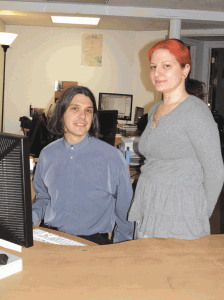
Rachael Frank and Rob Archer say creating an effective Web site is not something that can be done once and left alone.
This occurs frequently because most Web sites were built to be viewed on a desktop computer or laptop with a full-size screen. “A Web site built for a desktop assumes that people have the height and width on their screen that make it easy for them to see everything,” Winans said. There is also information that can be accessed using a computer mouse that will not work with the touch of a thumb, such as a drop-down menu.
“Traditional Web sites can be cumbersome for people using mobile devices,” he continued. “If they are not formatted for mobile users, the bounce rate of people who visit them, then leave quickly, is high,” Winans said, explaining that the term ‘bounce rate’ refers to the speed at which people leave a site that is not user-friendly.
Options Galore
Mobile Web sites can be formatted so that the information people are searching for is literally at their fingertips. “You want to create a layout that gives people a friendly experience when they visit across multiple platforms,” Winans said.
The first step is to determine what mobile users who call up a site are looking for. For most businesses, this is their phone number and address. “If people are looking for a restaurant on a mobile device, they probably don’t care about your history or where your chef trained,” Frank said. “They want your menu, but they want to be able to view it in a way that can be seen well on a mobile device. And this not a PDF, which is for printing purposes.”
That format does work well for people on a desktop computer, Archer said. “But you need to provide multiple solutions and have a responsive design that looks good on a 3- by 5-inch screen as well as a 7-inch tablet.”
Frank told BusinessWest that a mobile site is a separate entity from a traditional site and, therefore, requires a different form of navigation.
“A responsive design will automatically adapt to the size of a mobile device and do things like load a smaller picture or change a layout,” she explained. “This technology has been built upon for the last 10 years.”
And providing this platform can make the difference between keeping or losing a prospective client.
“If you’re pulling in a lot of business from outside of your area, it is important for someone on a mobile device to have the ability to check your hours of operation,” Frank said. “If they can’t get the information instantly or access directions easily, they are likely to go somewhere else. You want to make it easy for people.”
Archer provided another example. If someone is walking around Northampton and knows the name of a restaurant but has no idea where it is located, he explained, that information needs to be easy to find on their smartphone.
Winans agrees, and says design is critical to making a site user-friendly. “Since a phone is small, you want to have big buttons to show specialized content,” he said, adding that a mobile site can be linked directly to Google Maps. “People on mobile devices are usually trying to find several pieces of information quickly, and a mobile site can provide a different layout and change their experience.”
Tuneups
Archer says the maintenance required on a Web site can be compared to the work necessary to keep up a home’s lawn or garden.
“If you let a backyard go, it will end up with weeds and molehills,” he explained. “You need to cut the grass, water it, and make changes according to the weather conditions. And, like the weather, the technology landscape is continually changing, so your business needs to change along with it to keep up with the times.
“A Web site is often the first impression people have of your business,” he continued, “so when they see it on a mobile device, it had better look good and work well.”
Archer advises business owners who have the ability to make changes to their site to make sure the Google Analytics program is turned on. Last June, a new feature was introduced that shows the breakdown between mobile and non-mobile visitor activity on a Web site, including what type of device people used to access it.
Even if the numbers of mobile users are small, they are bound to increase. According to a report by eMarketer, half of the U.S. population will be using mobile devices, rather than computers, to access the Internet in 2015.
“The days of instant gratification are upon us, and it’s not enough to simply have a Web site or application. You need to be able to deliver content to anyone, anywhere, on any device,” Winans said.
He told BusinessWest that creating a mobile-optimized site from an existing Web site is not expensive. “It can be done for under $1,000 using a standard design,” he said. “And a large portion of businesses could definitely benefit from simple upgrades to their Web site. They can make a big difference.”
A mobile site can also serve as a starting point for a business that is considering an app. “You don’t need to jump into everything head first. There are definitely varying levels and ways of approaching it to minimize the up-front investment,” Winans said.
But building on a Web site requires a solid foundation.
“A lot of people can’t even change the content on their home page,” he noted, adding that he advises people to make sure their site has been built using a framework that can be expanded.
“If you have a good content-management system, it will allow you keep building rather than tearing down the structure each time you want to change something,” he continued, adding that some businesses may eventually want to add options such as e-commerce or video blogging.
Unfinished Business
Frank reiterated the fact that many small businesses have lagged behind the times. “They haven’t assumed their Web presence is important enough to develop,” she said. “But they need to build it and let it grow.”
Archer agrees. “Technology continues to grow, and we don’t know what is coming next,” he said.
So, although the future is unknown, experts say businesses need to make their products and services available in a way that shows they care. And right now, that means extending a friendly hand — or, rather, a design made for a thumb.
Could the Valley Become a Hub for Video-game Companies?
 Allan Blair freely admitted his understanding of the video-game industry is limited. Or was, anyway.
Allan Blair freely admitted his understanding of the video-game industry is limited. Or was, anyway.
“I had the simplistic view that gaming meant being frustrated by Angry Birds,” said Blair, president of the Western Mass. Economic Development Council (EDC). “The fact is, it’s truly a business, a real industry, and not just something to wile away time on. I had no idea.
“But once I got my mind around that,” he continued, “naturally, as an economic developer, I asked, ‘how do we nurture growth in this kind of industry in Massachusetts?’ As I learned about the industry, I came to believe we have in Western Mass. a lot of aspects necessary for this industry to grow and thrive.”
That was the general sentiment among more than two dozen panelists participating in “Digital Games: Playing in the Valley,” a recent symposium co-sponsored by host Hampshire College, the Mass. Digital Games Institute, and the EDC. The event drafted video-game entrepreneurs, professors from several colleges, political and economic-development leaders, and other speakers to discuss the potential of this fast-growing industry to take root and bring economic benefits to the Bay State.
“I am not part of what you would consider the ‘video-game generation,’ but video games encompass more than they used to,” said state Rep. Jim McGovern (D-3rd District). “Few industries these days can project the growth characteristics of the game industry … and those jobs should be in Massachusetts.”

Mike Levine says Western Mass. won’t reach its full potential in video-game development and related fields until the region is adequately wired for high-speed Internet.
“The Western Mass. region thrives on creativity and innovation, and I want to see these businesses blossom right here, and for these students to stay in the Valley and pursue their passion for video-game design,” McGovern said, noting that game technology has crossed over into other industries, from military training to medical applications, and is likely to expand further. “This is not a bunch of people talking about this in theory; this industry is growing now. And to get the economy back on its feet again, this is one of the answers.”
No Smokestacks
John Musante, Amherst’s town manager, called video games a potential “smokestack industry without the smokestacks. I enthusiastically believe that the gaming industry would be good for Amherst and good for our region.”
He mentioned that the three colleges in his town alone — UMass, Hampshire, and Amherst — include some 29,000 students at any given time, while others at the symposium noted that the 13 colleges in Western Mass. total some 65,000 students, many of whom are enthusiastic about gaming and might be likely to pursue jobs in the industry locally if they exist.
“Creativity and innovation are what our region is all about,” Musante added. “We believe the creative economy is part of our future, and the prominent potential of the gaming industry certainly seems like a perfect opportunity to build upon together, right here in the Valley.”
Take Raf Anzovin, for example. He launched Anzovin Inc., which creates character animation for games and other entertainment, in Florence in 1999 — a time when he was one of only a handful of people in the area doing that kind of work.
“There are both advantages and disadvantages to being in this area,” Anzovin said. “The cost of living is difficult to minimize. I’m not sure we could possibly start a small character-animation studio from nothing in a place where the cost of living wasn’t so low. We’ve also had a good relationship with the colleges; there’s a lot of good talent coming out of them, and that’s been very beneficial.”
Then there’s HitPoint Studios, a game-development outfit specializing in newer platforms such as social and mobile games. “We started HitPoint in 2008 with eight people in Greenfield,” said its founder, Paul Hake. “Now we’re in Hatfield with 37 people, and we’re anticipating growing quite a bit more.
“We’re excited about what’s going on in the Valley,” added Hake, who sees the region eventually becoming not just a mini-hub for the video-game industry, but a full-blown hub.
Musante said the region sells itself, especially at a time when industry professionals are virtually connected across the globe, and no longer have to be located in a major metropolitan center.
“We have a critical mass of higher education and talent. We have space,” Musante said, adding that the Pioneer Valley’s location less than two hours from Boston and less than four hours from Manhattan, combined with that aforementioned lower cost of living, is a major draw, as well as reputable public-school systems and the region’s natural beauty and outdoor activities. “We feel like we have a lot of things to nurture this industry so it can grow right here in the Valley.”
That growth is already happening, said Pat Larkin, director of the John Adams Innovation Institute, an arm of the Mass. Technology Collaborative. “In this region, the market has already spoken,” he argued. “Firms have flourished; they’re able to germinate, be disruptive, do startups, and grow on a sustained basis in this region.”
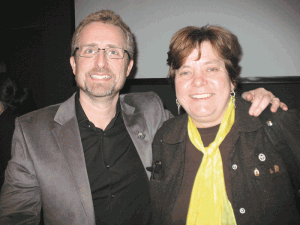
Ruth West (right, with Terrence Masson from Northeastern University) says the fact that game development requires both creative and technical skills is a draw for many students.
Getting Wired
The region poses some drawbacks, too — including one very basic problem in many rural communities.
“The Internet is really what made all this possible, in my opinion,” said Mike Levine, president of Pileated Pictures, an online- and mobile-entertainment studio in Shelburne Falls. “Amazingly, up in the hilltowns, many people do not have broadband. I really think this is a crime at this point; it’s like people not having electricity or television. That’s the number-one issue. Everyone should be connected in the state — not just for entertainment, but for public safety and other reasons.”
Hake agreed, noting that “broadband connectivity in Western Mass. is still not where it needs to be.” Another challenge, he said, is the lack of an experienced workforce to staff growing video-game companies. “We have huge amounts of talent coming out of the colleges, but we have a hard time finding industry veterans.”
There’s a sort of chicken-and-egg component to this issue, however, suggested Joe Minton, president of Digital Development Management in Northampton, which represents video-game-development studios; before that, he was president of game developer Cyberlore Studios.
Specifically, he said, the industry needs to expand in the region to attract that pool of available talent. “In San Francisco, you can walk down the street and meet five or 10 people willing to hire you.”
He talked about the importance of building critical mass in the region, forming a kind of ‘safety net’ so that talented designers, programmers, and others will know that, if one opportunity doesn’t work out, others will be available. Building many success stories, he said, “will make it much easier to bring talent here.”
Fred Fierst, a partner at law firm Fierst & Kane in Northampton, has represented video-game companies for 20 years, he said, amassing a strong reputation in the U.S. and overseas. But even he still sometimes encounters a “credibility issue” regarding Western Mass. that must be overcome. “They think if you’re not a New York or LA laywer, you can’t be a good lawyer; even a Boston lawyer is considered second-rate.”
Fierst noted another issue in video-game development, and that’s a pronounced dearth of women in the field. “I am constantly amazed how few women there are, and those who are [in the field] are in marketing and PR,” he said. “But that’s changing.”
Anzovin agreed. “I’d love to see more women in the industry,” he said, noting that he has worked with many female producers, but few artists and programmers — in other words, people on the creative side. “I don’t know that there’s a magical solution to that problem, but it’s getting better slowly.”
Back to School
Hake said colleges and universities are doing their part by recruiting more women into computer science and related programs.
Ruth West, associate professor and director of Computer Graphics at Springfield College, said the field has an appeal that should appeal to a wide variety of career seekers, no matter their gender. “It requires students to use their whole brain. It’s not just creative, but you have to think technically. There’s a whole mechanical side and a visual side, and it gets students to integrate their whole personality.”
It also requires professors to constantly keep up with trends, she said, which is why she and other faculty attend many conferences and continually track the industry in other ways.
“The only thing we can teach them is how to learn, because five years from now, it’s going to be something different,” West said. For example, social-media and mobile games have dominated the field recently. “I learned 56 programs, and they need to learn how to be that flexible.”
Paul Dickson, visiting assistant professor of Computer Science at Hampshire College, said video-game design is a motivator for students to learn many other skills. His program focuses on training students as generalists, so they can adapt to any platform, a trait valued by smaller video-game companies. Students who go on to specialized work — in a certain type of programming or animation, say — may find greater opportunities at larger companies.
“Games are a hook,” said Mark Claypool, professor and director of Interactive Media and Game Development at Worcester Polytechnic Institute. “We get students coming through the doors passionate about the things they’ve been playing. That’s gold, to get a student who comes to college excited about learning something … not just about the latest game, but the physical calculus, the music, the storytelling. There are lots of elements that have to go into the next great game.”
Or the next great … whatever. “There are many applications outside entertainment,” Claypool said, “and that’s where the real action is going to be; that’s where the real money is.”
McGovern said Massachusetts clearly has the intellectual capital to build on this work and be an innovator in those future applications, adding that state leaders are continually trying to determine how best to invest in those growing industries through infrastructure and research dollars.
“I feel like there’s a renaissance period going on now,” Pileated’s Levine said, noting that, when he was in school, video games weren’t even mentioned as a possible career path. “Now we actually have schools teaching programs, and kids coming out of school knowing game design.
“I think it’s a very exciting time,” he continued. “As a company, we’re really interested in growing our business in this region, and we need young talent who understand mobile and social gaming far more than we do. What we learned was a very different business model. Things are changing very rapidly.”
And because of online connectivity, breakthroughs can happen anywhere, Minton said. “The world is flat, and it’s really exciting what can be done nowadays.”
He cited Rovio, the Finnish maker of the Angry Birds franchise. “This was a small company making a number of games that weren’t very successful,” he noted. “Now they have many, many hundreds of people. It just takes one hit — and there’s no reason that can’t happen here.”
Joseph Bednar can be reached at [email protected]
A chart of area computer network/IT Services
Click here to download PDFComputerNetworkITservicesBW1011b
Apple Looms Large, but Competition Abounds in Tech Marketplace
Though its visionary leader, Steve Jobs, passed away earlier this fall, Apple continues its impressive momentum. If the iPad — which proved to be an über-popular media-consumption tool among all age groups, kids to senior citizens — was the tech product of 2010, its successor, the iPad 2 ($499 and up), raises the bar even further.“Though the iPad 2 is an improvement on the original iPad in numerous ways, it’s still an evolutionary product, not a revolutionary one,” MacWorld reports. “If you’re happy with your current iPad, there’s no reason to dump it just because there’s a shinier, newer one.”
Yet, the magazine notes, some of the product’s deficiencies have been remedied, while the design is even smaller and thinner than before.
The iPad 2 uses a new, Apple-designed processor called the A5, a dual-core version of the 1 GHz chip that powers the iPhone 4 and last year’s iPad. The new model also boasts 512 MB of RAM and processing speed significantly faster than before. Notably, it also adds front- and rear-facing cameras.
“The first iPad was a bolt from the blue, a device that defined an entire category, and a tough act to follow,” MacWorld concludes. “The iPad 2 follows it with aplomb.”
The product isn’t without challengers, however. The Motorola Xoom, according to Popular Mechanics, “hits one cutting-edge mark after another,” featuring an Android 3.0 Honeycomb operating system, plenty of power with a dual-core 1 GHz processor, 1 GB of RAM, and both front- and rear-facing cameras for videoconferencing as well as shooting photos. The high-resolution, 10.1-inch screen impresses, too.
“For now, the Xoom is a step ahead of the competition when it comes to connectivity,” the magazine notes, after launching on Verizon’s 3G network in the spring and moving to 4G with subsequent shippings. And HDMI compatibility means that the Xoom ($499 and up) can share its video with a home-entertainment center.
Amazon — which updated its e-reader offerings in 2011 with the Kindle Touch 3G ($149) or without 3G ($99), as well as a non-Touch Kindle ($79) — made its biggest splash in the tablet market, by launching the Kindle Fire, a 7-inch tablet with a very attractive $199 price tag.
The Fire features a dual-core processor and 8 GB of storage, and promises 7.5 hours of video playback on one charge. Although it has a USB port for file transfers, it offers neither a camera nor a microphone.
“But this tablet isn’t supposed to be about tech specs,” according to PC World. “It’s meant to be a dead-simple slate for consuming Amazon content. At the top, the interface has a search bar that can search locally, in the cloud, and on the Web. Below that is a strip of content categories, followed by a stylized list of recent content. On the bottom of the screen, users can pin their favorite apps, books, and other media.”
Time will tell how much an Amazon-centric tablet at a comparatively low price will cut into the market for iPads and their ilk; the Fire ships Nov. 15, but Amazon has been taking pre-orders for months.
Smartphones and Laptops
Apple has upgraded its smartphone line with the iPhone 4S, which Engadget calls “a new spin on an old phone that will shock none, but give it half a chance, and it will still impress.”
The 4S ($199 and up) runs on the same new dual-core processor powering the iPad 2, and while RAM remains the same at 512 MB, its maximum storage has doubled to 64 GB (in the $399 model). Its most notable feature might be Siri, a ‘digital helper’ with advanced voice recognition that some users have found uncanny.
“Siri can do a huge number of things, from sending texts and e-mails to finding restaurants and getting directions from one place to another — things that, it must be said, could largely be done before by voice on other devices and platforms,” Engadget notes. “It’s really the enhanced ability to understand casually spoken English mixed in with the notion of context that sets this apart.”
“But the phone is a game-changer because of its laptop and HD multimedia docking systems,” it goes on. “As soon as you plug the phone into either dock, a full-fledged Firefox browser launches, your Android apps scale up in size, and you leave thumb typing behind.” In addition, the multimedia dock has three USB ports and an HDMI port, so it can power plenty of entertainment equipment.
For consumers in the market for an attractive, lightweight notebook computer, PC World calls the Asus U36S “pretty darn close to perfect.” Aside from speakers that leave something to be desired, the magazine says this super-thin ultraportable has all the features the average user could want — and more.
The review model ($870) features an Intel Core i5 processor, 4GB of RAM (which can be upgraded to 8GB), a discrete Nvidia GeForce GT 520M graphics card, and a 640 GB hard drive. It also features built-in wi-fi and Bluetooth, and runs a 64-bit version of Windows 7 Home Premium.
It’s also a slim machine, at 3.7 pounds and 0.75 inches thick, except for a battery compartment that bumps out to 1.1 inches. That battery tests at between eight and 10 hours of use.
For something a little more pricey, CNET raves about the 13-inch MacBook Air ($1,299), which has been updated with the latest Intel CPU for better performance and battery life. Although its 128 GB SSD drive is smaller than a standard hard drive, the model still vastly outperforms its predecessor. The new second-generation Core i5 processor is a jump of two Intel generations. And it now includes a backlit keyboard, a popular feature dropped in the previous generation.
With 4 GB of RAM and 128 GB of SSD storage, CNET notes, the 13-inch Air is a better bet for trouble-free mainstream computing than the 11-inch version, which offers only 2 GB of RAM and a 64 GB SSD. Its performance approaches that of the more expensive 13-inch MacBook Pro, and its battery life is excellent.
Cameras and Other Fun Stuff
“The usual caveats apply: it’s not the right camera for everyone, and it’s not best at everything,” the site notes. “But its combination of design, feature set, performance, and photo quality for the price is hard to beat (and will be especially so once the street price starts to drop).”
For those more interested in video, PC World praises the Epson Megaplex MG-50 ($699) and MG-850H ($799) portable projectors.
These units (the price difference reflects video resolution and brightness) have an iPad-, iPhone-, and iPod-compatible dock on the front and can project large, high-resolution videos or still images from the content stored on those units or from online sources such as YouTube. The MegaPlex units also work with a variety of other devices.
Speaking of the iPod, Apple’s latest iPod Touch, now on its fifth generation, comes with a variety of features. “It records HD video, chats over video or iMessages, checks your e-mail, keeps your appointments, connects to the cloud, rents movies, plays music, takes pictures, and plays more games than any of its competitors,” CNET reports. It’s priced from $199 (8 GB) to $399 (64 GB).
Music, movies, photos, games. Increasingly, today’s mobile high-tech products do all of these and more. For a society of voracious media consumers, it’s an exciting time, and 2012 only promises more evolution, and perhaps a revolution or two as well.
Just like Steve Jobs would have wanted.
Joseph Bednar can be reached at [email protected]
Local Firm Is on the Cusp of a Microchip Breakthrough
Steven Frank, Jef Sharp, Jeff Hausthor, and Stephan Rogers are heading up a team whose work is so revolutionary that customers who hear about it say it is almost too good to be true.“The feedback we are getting shows that what we are doing is the Holy Grail,” said Frank, CEO of Panève LLC, a Hadley-based management and engineering firm.
The mission of the company, founded two years ago by the four seasoned entrepreneurs, is to develop a new software-programmable, general-purpose microchip processor built from the ground up for video and graphics-intensive applications. Its use will cover a wide range of products that make life better for people and run the gamut from TVs to gaming devices to green-energy applications and medical apparatus.
The product, called the RhinoCore, is in final stages of development, said the partners, and will solve an industry problem by reducing costs as well as the time it takes to get new products to the market, while allowing programmers to write innovative applications.
“When most people think about computers, they think about PCs,” Frank said. “But a revolution is happening; computers and processors are embedded in all sorts of devices such as smartphones, tablets, and TVs.”
The number of computer chips used by manufacturers today is staggering. Sharp, founder of the Northampton-based IT solutions company TechCavalry, says the Toyota Prius he drives contains more than 50 computer chips. “A lot of people don’t know how many chips there are in everyday products today. The trend is exploding.”
What makes Panève’s work so groundbreaking is that its processor allows conventional software to take advantage of multiple chip cores as if they were one, Frank said.
He explained that, over the past four or five decades, semiconductor technology has advanced very rapidly and enabled a swift progression in the capability of products at a lower cost. “But that capability hit a technical wall. Over the past five years it has become apparent that we can’t make processors go any faster,” he said.
An example the average consumer can easily understand is that computers often contain multiple processors. “But each one is not faster, so the real problem that no one has figured out is how to make a software platform that will coordinate all these processors and make them work as one,” Frank said.
But the partners are happy to say they think they have solved that problem.
When the Chips Are Down
The mission began about seven years ago when one of the largest TV manufacturers in the world approached Frank with a problem — and an opportunity.
“They wanted to build a TV where all of the work inside was done with software. Instead of building a TV with special-purpose hardware chips, they needed a software-programmable chip that would be applicable to a large market, enable them to get their products to the market faster, and allow them to continually upgrade the device,” he said, adding that the cost of building a new computer chip is tens of millions of dollars. “What they wanted required a supercomputer in a TV, and there was no company that made a product like that.”
Frank was the chief technical officer (CTO) at Kendall Square Research, a leading supercomputer company that he had co-founded. “At the time that I was approached to put supercomputer thinking into a chip for consumer electronics, I was doing consulting work. The solution to the problem they presented me with was not obvious, but I had the framework to solve the problem because of my years at Kendall Square Research.”
Frank spent several months thinking about the problem and worked with the TV company’s consultants to redefine what was needed.
His work was essentially put aside as his wife waged an unsuccessful fight against breast cancer, but the television firm encouraged him to continue and to start a new business that would focus on a solution.
Two years ago, Frank joined together with his trio of partners who are engaged in making history. He said they have been able to operate on a budget due to their business model.
Three models exist in the semiconductor business world, they explained. One is made up of companies that design their own chips and own factories that produce them. Another simply does the design work and gets the chips ‘fabbed’ which means fabricated in tech-speak, while the third develops the design and licenses it to semiconductor and consumer-electronics companies that manufacture and sell the chips.
Panève fits into the third category, which allows it to develop technology without a tremendous amount of capital. “Our customers are semiconductor companies who sell to large consumer-electronic manufacturers like Sony, Sharp, or Samsung, who will use our technology to make the next-generation devices,” Sharp said.
Panève has met success in its quest to design a platform for a new type of chip that is software-programmable. “It will open up innovation for tens of thousands of programmers to come up with new ideas and new functionality,” Sharp said.
Frank offered two examples of how it can be used. High-end cars that are able to detect when other vehicles are nearby or when the driver is falling asleep need advanced image processing in real time, which is very expensive. “But our chip will make it easy to write software so the technology can be put into mid-priced vehicles,” he explained. The other example is that animated movies seen on televisions and smartphones look almost real on those media, but look ‘cartoonish’ on gaming devices because of the way the algorithms work with the processor. “Our chip will allow them to take a big jump in visual quality,” Frank said.
A Competitive Edge
A study conducted by the White House Science and Technology Advisory Council concluded that, over the past 15 years, hardware improvements have made computers 1,000 times faster. “The study also found that, in the same amount of time, software was responsible for making computer performance increase 43,000 times.
“Software is really a driver for new devices and the quality of life we are experiencing today,” Sharp said.
And it goes far beyond games, TV, and automobiles.
“New advances in medical-science imaging, renewable energy, and devices that use processors to help wounded veterans walk again are all examples of embedded processors at work, and we are proud to be developing a breakthrough platform that will help these kinds of technologies to improve further,” Sharp said. “What we are doing breaks through a wall that will enable continued increases in computer performance. When people think of technology, they think of gadgets, but in hospitals the amount of equipment driven by computers is incredible and enables us to live fuller, richer, and happier lives. It is an increasing part of the fabric of daily life.”
The company is finalizing a prototype that is very sophisticated and nearly ready to be brought to the market.
“Our belief that it is revolutionary is based on conversations we have had with dozens of companies who dream big and have given us feedback that this is almost too good to be true,” Frank said. “Computing is so pervasive in everything we do and everything that is important to us.”
The work has not been easy, however. “We have a team of 16 people who are making this happen through sweat and tears,” Sharp said. “But we are enjoying building something of substance and contributing to society. It’s a lot of work and involves a lot of challenges, but it is very satisfying to make progress.”
He added they would not be able to proceed without support from investors. “They are a very important part of this, and hopefully our work will inspire additional investment in other small companies,” Sharp said.
Summing it up, Frank said that “our work offers a triple play. It will make technology less expensive, more capable, and faster, and allow products to function in ways we can only dream about today.”





